How to Create an Effective Dissertation Presentation
For many students, the task of writing a lengthy dissertation is so daunting that they forget about the need for Dissertation Presentation! Amidst all the hard work of researching and writing, students in some courses still need to prepare for a high-quality presentation that will help them earn top marks. This article will help you prepare and give you some essential tips for success.

The Purpose of Dissertation Presentation
There are two main types of Dissertation Presentation that are normally encountered in UK universities:
Mid-Research Presentations
Students will often be asked to present their dissertation work at a mid-point in their research. These presentations are usually made to a panel comprised of various faculty members from your department. In addition, they are sometimes structured as a postgraduate seminar, in which fellow students also attend. Both faculty and students can pose questions. The purpose of these Mid-Research Dissertation presentations is to provide students with an opportunity to demonstrate their progress and identify any weak areas that need to be addressed.
Assessment Presentations
Students are also sometimes required to make a Dissertation Presentation as part of their overall assessment . This is a much more formal presentation than the Mid-Research one, and it is usually open only to the student, examiners and the research supervisor. During an Assessment Dissertation Presentation, the student is required to present a summary of their research and results. They will then be asked questions by the examiners in a somewhat lengthy oral examination. The purpose of this Dissertation Presentation is to assess the student’s original research project and test its scholarly validity.
Differences in Undergraduate and Masters Presentations
Dissertation Presentations may be required at both Undergraduate (Bachelors) and Postgraduate (Masters) levels. The key difference between these levels is the length and degree of originality expected. Postgraduate Dissertation Presentations will normally be longer than Undergraduate Presentations, and they will demonstrate a greater degree of critical engagement with the subject matter. They will also demonstrate some degree of original thinking. By contrast, most Bachelors Dissertation Presentations will be shorter in length and will only require a thorough knowledge of the topic rather than an original scholarly contribution of any kind.
What to Include
- Broad subject area – What subject area of your discipline does your work fall into?
- Narrow topic area – Within this subject area, what is your specific topic? (This may be simply an expanded discussion of your research title).
- Relevant Existing Studies – What studies have already been done on your specific topic? What are their strengths and weaknesses? How does your work fit among them?
- Methodology and Philosophy – What methodology have you chosen to conduct your research? Is there a specific philosophical context? Why is this a good approach?
- Project Resources – If this is a Mid-Research Presentation, what resources do you require to complete the project? Furthermore, have you identified likely sources of funding, or do you need any difficult-to-acquire materials?
- Case Studies – If you’ve conducted practical fieldwork or lab research, why did you choose these cases or projects? How are they the best choices for researching your topic?
- Research Results – If this is a Dissertation Presentation for Assessment, note the results of your research in detail. Relate these back to your theoretical framework and discuss how the results support or contradict existing studies.
How to Prepare for your Dissertation Presentation
The best way to prepare for your Dissertation Presentation is to review your work carefully. Take notes of the key decisions you have made throughout your research and the scholarly literature that supports these choices. Make sure that you have a thorough understanding of the scholarly context of your research, which should have been achieved in your early research stages.
Once your content has been written, you should create a PowerPoint presentation to use during your talk. Don’t forget the slides should be informative but not wordy – keep bullet points concise and use pictures sparingly. Make sure that you rehearse your presentation several times.
What Sort of Questions to Prepare For Dissertation Presentation
The questions you will face in a Dissertation Presentation are designed to test your knowledge of the subject area and your awareness of the context of your work. You will be asked questions to determine how well you understand the potential criticisms of your project, and how well you are able to defend this. Therefore, remember to reference established scholars and existing research.
You might be asked about the specific choices you’re made with regard to methodology and case studies, and how you accounted for any possible inaccuracies in your resulting data. Similarly, examiners frequently ask students what they would do differently if they were starting the same project again.
You should also be prepared to answer questions about the ways your research might be applied within your field, and how it might be supplemented in future. This is an effective way for examiners to assess the originality of your research, and consider its potential impact on your subject area.
How to Earn a High Mark
Much of your dissertation mark will come from the written work and the research project it represents. However, a good Dissertation Presentation will help make a strong case for a good overall mark, whereas a weak Presentation will confirm any doubts in the examiners’ minds. As such, here are a few key areas for success:
- Good Presentation Skills. As with any Presentation, it is important to speak clearly and concisely. Stand still and look your audience in the eye, and try not to rely too much on notes. Be sure to keep breathing and don’t rush your words!
- Knowledge of the Topic. If you truly have a good understanding of your topic you will be likely to do very well. Remember, much of the Dissertation Presentation is designed simply to test your knowledge. If you’ve kept pace with your reading assignments and practical work you should have no problem answering any questions that are posed to you.
- Professional Behaviour. Stay calm and focused during your Presentation, and answer any questions with objectivity and professionalism. Don’t be drawn into debates, but instead offer references to other scholars whose work supports your own agenda.
- Take Your Time . Many students make the mistake of rushing through their material and answering questions too quickly. This doesn’t give the audience a chance to thoroughly understand the quality of your work. Furthermore, it risks leaving out essential information and neglecting to demonstrate the depth of your research.
- Apr 11, 2023
How to design an impactful 3MT slide (with examples!)

What can you do in three minutes? Brush your teeth, make a coffee?
How about explain your entire PhD thesis? 😅
Believe it or not, that’s what thousands of people do each year in the Three Minute Thesis (3MT ® ); a global public speaking competition where PhD students explain the scope and impact of their research in, you guessed it, just three minutes . ⏰
And if you’re reading this, perhaps you’re an aspiring 3MT-er yourself, on the hunt for some inspiration to design an impactful 3MT slide to accompany your talk.
Sound like you? Then you’ve come to the right place.
Previously, we gave you some tips and tricks on how to write a winning 3MT script , but in this instalment of our 3MT series, we’re switching gears to cover another very important aspect:
We’ve trawled the internet to discover what actually makes a good three minute thesis slide, and in this blog, we’ll cover some do’s and don’ts to help you design one that’s memorable and impactful. To help bring these concepts home, we’ll also include some examples that we love from past 3MT winners and finalists.
But before we do that, let’s recap some important rules related to the 3MT slide:

So, in short, the 3MT slide obviously needs to be fairly simple. But that doesn’t mean it has to be boring.
Hold up… if the 3MT is a public speaking competition, why is the slide even important? Surely only what you speak about matters, right? WRONG! 🙅♀️
The 3MT competition is about so much more than just what you say. It’s also about what you do and what you show And what you show during your 3MT is where your nifty little slide comes in.
Not only is the PowerPoint slide a key component of the 3MT judging criteria , it also helps create a lasting mental image for the judges. After all, you can’t win the 3MT if the audience and judges can’t even remember what your research is about!
So, hopefully we’ve been able to convince you about just how important having a good slide is. But how do you design an impactful 3MT slide, you ask?
Well, here are 5 of our top tips:
Tip #1 : Avoid data dumping 📊
You might be familiar with those boring old PowerPoint presentations that seem to appear at every conference. You know the ones I’m talking about. The ones cluttered with complex graphs, huge tables, and enough numbers to put even the most experienced professors to sleep.
May I present to you… Exhibit A:

Look familiar? Good. Now lock the memory away in a distant room of your mind palace, because that’s exactly what you DON’T want in a 3MT slide (or really, in any slide for that matter…)
Unlike a conference presentation, your 3MT slide should simply act to enhance and complement your script, rather than be used to display complex data and graphs. In fact, I would suggest avoiding the use of any complex graphs and data tables at all, because they just end up detracting attention from what you’re saying.
If you choose to present some important data or statistics in your 3MT slide, consider swapping out graphs with simple infographics , like pie charts or diagrams:

As you can see, simple infographics and eye-catching figures are a much more visually stimulating way to present information, especially compared to data-heavy graphs and tables. And they’re surprisingly easy to make using tools like Adobe Illustrator and Adobe Express .
So, if in doubt, leave complex data out. 🚫
In fact, you’ll find that most successful 3MT-ers show little to no data at all in their slides and intentionally keep them very conceptual, which brings me to tip #2 .
Tip #2 : Keep it conceptual 💡
Perhaps you’re sensing a general theme here… that typically less is more when it comes to a 3MT slide. This allows the focus of the presentation to be on the speaker, the slide simply acting as a visual aid to complement the story . And when it’s a public speaking competition, I’d say that’s pretty important.
In our humble opinion, some of the most effective and memorable 3MT slides are those that present an image or diagram that conveys a single underpinning concept or idea .
You might recall from our ‘ How to Write a Winning 3MT Script ’ blog post, that many successful 3MT scripts incorporate things like humour, analogies , or fictional characters. In these situations, it can be helpful for the contents of the slide to reflect this.
One of my favourite examples of this comes from 2016 Asia-Pacific 3MT Winner, Joshua Chu-Tan , who spoke about his research on gene therapy treatments for age-related macular degeneration (AMD) to target the root of vision loss. In his winning presentation, he says:

Rather than using complex diagrams to show the theory, he opted for this simple, yet extremely powerful image that highlights the impact of vision loss from age-related macular degeneration. And, seeing as this image has stuck in my memory for years, I’d say it was a pretty good choice.
As another example, back when I won the 3MT , I used an analogy to draw parallels between A) cars carrying passengers on a highway, and B) nanoparticles carrying drugs along a blood vessel. So, my 3MT slide portrayed a busy highway with signage to show which hypothetical organs the cars were headed towards:

Basically, the overarching message is to keep it simple.
And that’s all well and good… But where do you even start?
Your first step is to write your 3MT script . Then, once you have your script prepared, use it as a tool to help you brainstorm ideas for your slide. Note whether you’ve used any analogies, introduced any characters, or covered certain concepts, and then based on this information, find or create a visual to match! 🖼 This might be a little different to your usual scientific presentations, where you would normally prepare your slides first, then come up with what you are going to say after, but trust me – it works!
Tip #3 : Choose an eye-catching visual… or make one 👀
In the same way that ‘ the hook’ in your 3MT script helps to pique the audience’s attention, the slide is another important tool to capture their attention and keep them engaged. But to do this, it needs to be eye-catching and interesting .
We’ve noticed that most winning 3MTs have slides that generally fall under one of two categories: images or diagrams .
These are usually photographs or illustrations that complement the script in some way — containing a reference to the concept, analogy or character(s) that were introduced in the script.
For example, let’s say you introduced a fictional character in your 3MT script. By visually showing this character in your slide, it helps the audience form a connection with them and taps into their sense of empathy. Let’s look at an example:

As you can see, using this photograph makes for a really effective and impactful slide because it elicits a strong emotional response. Come on… how can you not love that adorable little face, right? 🥺
However, the images don’t have to be of people to be effective – they can also be more conceptual.
For instance, one 3MT finalist spoke about their research on detecting diseases, like cancer, based on characteristic molecules present in the breath. In their slide, they showed an illustration of breath molecules exiting the lungs and mouth to be caught in a net:

Not only is this image a great reference to the net analogy used, but we (as the audience) are able to get a basic idea about the research concept based on the slide alone, which really helps it stick in our memory!
Of course, while we’ve highlighted some great examples, you should choose whatever image speaks to you and your research. Some useful resources to find images for your 3MT slide include iStock Photo and Adobe Stock Photos (making sure to provide attribution where required), or you can even be extra creative and take your own photo, or create your own image ! 📸
Aside from images, schematic diagrams can be another great way to conceptualise and visualise your research. However, to be effective as 3MT slides, the diagrams need to be simple and easy to understand.
Ideally, they should be short, and the outcomes immediately recognisable . Avoid using complex diagrams that you’ve directly copy-pasted from a paper, as these generally take a lot more time and concentration to understand.
A good example of a diagram for a 3MT slide was used by the 2020 Asia-Pacific 3MT winner , whose research focused on the development of a liquid glue to help measure electrical signals from plants as a way to measure their health:

In this example, it’s easy to understand what the research is about, what’s being measured, and what the desired outcomes are, thanks to the clear illustrations and emotive flower drawings.
So, if done well, diagrams can be a really powerful tool to conceptualise your research. If you want to try and create one yourself, there are lots of useful tools you can use, like Adobe Illustrator , Canva , or BioRender , to name a few.
Get creative!
Tip #4 : Minimise text 💬
When it comes to presentations, there’s nothing worse than being in the audience, staring at a PowerPoint slide, only to find a wall of text staring back at you. Not only is it super distracting, but aesthetically, it also leaves much to be desired.
And let’s be honest, if the audience is reading your slide, then they’re not listening to you… and vice versa. Which, for the 3MT, is a very big problem.
To prevent this, try to avoid including large bodies of text on your 3MT slide . See if you can verbally communicate the information instead, or alternatively, replace the text with an image that conveys the same message. After all, they say a picture speaks a thousand words.
If you really need to include some text, as in the case of simple diagrams, try to keep it to a minimum and limit yourself to 15 words maximum.
Any text you do include should use a font size that can be easily seen from the back of the room (i.e., 24 pt. minimum). And, while they sometimes have their time and place, try to avoid using any cursive, funky, or hard-to-read fonts . Comic sans, I’m looking at you. 😒
Tip #5 : Negative space is your friend 🔲
You might be tempted to fill every visible inch of your PowerPoint slide with images, diagrams, or just something to compensate for the very little time you have to present your 3MT.
Though, you’d be doing yourself a disservice if you did, because a little negative space can go a long way towards designing a great 3MT slide.
But what is negative space? Put simply, it’s the empty space around and between objects.

Leaving some negative space in your slide gives the audience some breathing room and helps them focus on what’s important .
For photographs, this might mean choosing an image that has one focal point. This doesn’t necessarily mean the background needs to be plain, but it may simply be out of focus to allow the objects in the forefront to stand out.
For diagrams, this means leaving some empty space between sections so that there’s a clearer distinction between them, or reducing the number of sections entirely.
Here are some great examples of 3MT slides that use negative space to draw our attention to a particular person or object:

By leaving some negative space, our eyes are immediately drawn to one particular focal point, letting us focus on what’s important: You.
The take-home message 📝
And that brings us to the end of the second blog for our 3MT series!
The 3MT slide can truly make or break a 3MT presentation, but the right one can take it to the next level. And, by following these simple tips, you’re well on your way to designing a slide that captures your research in an effective and impactful way:
Avoid complex graphs and data
Keep it conceptual
Choose an eye-catching image or diagram, or make one
Keep text to a minimum, and
Don’t be afraid of negative space
So get creative! And remember, if you want to learn more about how to create amazing graphics, or how to up your public speaking skills, we’d love to show you how in our in-person science communication workshop s or online courses!
Contact us here to find out more. 🤩
Cintya Dharmayanti
Dr Tullio Rossi

Related Posts
How to write a winning 3MT script
5 epic science communication conferences for your travel bucket list
The history of science communication methods and their evolution over time
Comentarios


Princeton Correspondents on Undergraduate Research
How to Make a Successful Research Presentation
Turning a research paper into a visual presentation is difficult; there are pitfalls, and navigating the path to a brief, informative presentation takes time and practice. As a TA for GEO/WRI 201: Methods in Data Analysis & Scientific Writing this past fall, I saw how this process works from an instructor’s standpoint. I’ve presented my own research before, but helping others present theirs taught me a bit more about the process. Here are some tips I learned that may help you with your next research presentation:
More is more
In general, your presentation will always benefit from more practice, more feedback, and more revision. By practicing in front of friends, you can get comfortable with presenting your work while receiving feedback. It is hard to know how to revise your presentation if you never practice. If you are presenting to a general audience, getting feedback from someone outside of your discipline is crucial. Terms and ideas that seem intuitive to you may be completely foreign to someone else, and your well-crafted presentation could fall flat.
Less is more
Limit the scope of your presentation, the number of slides, and the text on each slide. In my experience, text works well for organizing slides, orienting the audience to key terms, and annotating important figures–not for explaining complex ideas. Having fewer slides is usually better as well. In general, about one slide per minute of presentation is an appropriate budget. Too many slides is usually a sign that your topic is too broad.

Limit the scope of your presentation
Don’t present your paper. Presentations are usually around 10 min long. You will not have time to explain all of the research you did in a semester (or a year!) in such a short span of time. Instead, focus on the highlight(s). Identify a single compelling research question which your work addressed, and craft a succinct but complete narrative around it.
You will not have time to explain all of the research you did. Instead, focus on the highlights. Identify a single compelling research question which your work addressed, and craft a succinct but complete narrative around it.
Craft a compelling research narrative
After identifying the focused research question, walk your audience through your research as if it were a story. Presentations with strong narrative arcs are clear, captivating, and compelling.
- Introduction (exposition — rising action)
Orient the audience and draw them in by demonstrating the relevance and importance of your research story with strong global motive. Provide them with the necessary vocabulary and background knowledge to understand the plot of your story. Introduce the key studies (characters) relevant in your story and build tension and conflict with scholarly and data motive. By the end of your introduction, your audience should clearly understand your research question and be dying to know how you resolve the tension built through motive.

- Methods (rising action)
The methods section should transition smoothly and logically from the introduction. Beware of presenting your methods in a boring, arc-killing, ‘this is what I did.’ Focus on the details that set your story apart from the stories other people have already told. Keep the audience interested by clearly motivating your decisions based on your original research question or the tension built in your introduction.
- Results (climax)
Less is usually more here. Only present results which are clearly related to the focused research question you are presenting. Make sure you explain the results clearly so that your audience understands what your research found. This is the peak of tension in your narrative arc, so don’t undercut it by quickly clicking through to your discussion.
- Discussion (falling action)
By now your audience should be dying for a satisfying resolution. Here is where you contextualize your results and begin resolving the tension between past research. Be thorough. If you have too many conflicts left unresolved, or you don’t have enough time to present all of the resolutions, you probably need to further narrow the scope of your presentation.
- Conclusion (denouement)
Return back to your initial research question and motive, resolving any final conflicts and tying up loose ends. Leave the audience with a clear resolution of your focus research question, and use unresolved tension to set up potential sequels (i.e. further research).
Use your medium to enhance the narrative
Visual presentations should be dominated by clear, intentional graphics. Subtle animation in key moments (usually during the results or discussion) can add drama to the narrative arc and make conflict resolutions more satisfying. You are narrating a story written in images, videos, cartoons, and graphs. While your paper is mostly text, with graphics to highlight crucial points, your slides should be the opposite. Adapting to the new medium may require you to create or acquire far more graphics than you included in your paper, but it is necessary to create an engaging presentation.
The most important thing you can do for your presentation is to practice and revise. Bother your friends, your roommates, TAs–anybody who will sit down and listen to your work. Beyond that, think about presentations you have found compelling and try to incorporate some of those elements into your own. Remember you want your work to be comprehensible; you aren’t creating experts in 10 minutes. Above all, try to stay passionate about what you did and why. You put the time in, so show your audience that it’s worth it.
For more insight into research presentations, check out these past PCUR posts written by Emma and Ellie .
— Alec Getraer, Natural Sciences Correspondent
Share this:
- Share on Tumblr

How to Pull Off Your Thesis Defense With a Great Presentation

You’ve reached the home stretch in your journey toward your post-graduate degree. You’ve diligently studied, researched and performed for years, and all that’s left is your master thesis or doctorate dissertation.
“ All that’s left,” however, might be the understatement of the century. There’s nothing simple about orally defending your thesis, and this final stage often means the difference between a degree and a program that remains incomplete.
Even after you’ve dedicated months filled with blood, sweat and tears defining your argument, researching your support and writing your defense, you aren’t ready to address the academic panel. You still have to design an effective visual presentation, and the slide deck can make or break your entire thesis.
Unsure how to design a stellar slide deck to visually present your thesis or dissertation? Check out the following tips to pull off your master thesis defense with a great presentation:
1. Properly structure your slide deck
Every master thesis defense presentation is unique, but most effective slide decks will follow a similar structure, including:
- Title - Just like a research paper, your thesis presentation must include a title slide. This should include the same information as any other title page: the title, your name, your academic institution, course name and the name of the academic advisor to your thesis or dissertation. That doesn’t mean your title slide needs to look like the start of any other Frankendeck . Instead, add your text atop a relative image, and adjust the brightness to ensure your text pops.
- Introduction - Your thesis presentation should also include an introduction slide, which details the topic of your thesis, the question your research will seek to answer and any additional objectives to your research, as well as the answer or solution you will be defending.
- Literature review - Following your thesis introduction, design one or more slides that review the literature you researched. This shouldn’t be a full bibliography (although that should be included in the accompanying written account of your research), but instead, the slides should list your most relevant research sources. If the information is featured on a slide, make sure you include its source.
- Methodology - Your thesis presentation slide deck should also include a slide (or slides) detailing the methodology of your research and argument. Here you want to describe the type of study— whether it’s quantitative, qualitative or a combination of the two, as well as an explanation of why you chose the method or methods you used. If you conducted original research, you will want to detail the study population, sampling methods and other details pertinent to your studies, while you’ll also want to detail how you analyzed your data.
- Results - No thesis presentation slide deck is complete without dedicating slides to illustrate the results of your research. Be sure to include a description of any data you collected through your research, as well as the results of your analysis of the data. What were your most significant findings?
- Discussion - How do the results of your research support your overall thesis argument? Be sure to include slides that discuss your overall findings and how they relate to your original question.
- Conclusion - Concluding slides should restate your original research questions, represent the results of your research, suggest future research and make any final recommendations.
- Ending slide – Close your thesis presentation with a concluding slide that offers an interesting quote or trivia that makes your audience further ponder your topic, a GIF or animation that recaptures the audience’s attention or even a hypothetical question that opens additional discussion from the academic panel. This is your opportunity to make your presentation memorable.

Thesis Presentation vs. Dissertation
Thesis presentation and dissertation are two terms often used in academic settings related to upper education. While they are related, there are distinct differences between the two, which is important to understand as you begin to structure your thesis defense.
A thesis presentation typically refers to the final oral presentation that a student gives to defend their thesis or research project. It is a formal presentation to explain their findings, methodology, and conclusions to a panel of faculty members or experts in the field. The purpose of a thesis defense presentation is to demonstrate the student's knowledge and understanding of the subject matter and to defend the validity of their research.
On the other hand, a dissertation refers to a lengthy and comprehensive research project that is typically required for the completion of a doctoral degree. It involves in-depth research, analysis, and the development of original ideas in a particular field of study. A dissertation is usually written over an extended period and is expected to contribute new knowledge or insights to the field. Unlike a thesis presentation, a dissertation is submitted in written form and is typically evaluated by a committee of faculty members or experts in the field.
2. Choose which ideas to illustrate
Unless you have an hour to fill with your master thesis defense or doctorate dissertation, you won’t be able to include every idea from your overall research documentation in your slide show. Choose the most important ideas to illustrate on slides, while also keeping in mind what aspects of your research you’ll be able to visually represent.
.webp)
3. Define your presentation’s theme
A stellar thesis or dissertation presentation will be professional in appearance, and a cohesive design is an absolute must. Choose what types of typography and color schemes best support your topic.
Instead of adjusting these settings on each individual slide— a tedious task at best— choose a PowerPoint-alternative presentation software like Beautiful.ai that allows you to customize a theme for your entire slide deck. Choose your fonts and other typography, your color palette, margins, footers, logos, transitions and more, and the cloud-based tool will automatically apply those design specifications to every slide you add to the master thesis defense presentation.
4. Design simple and focused slides
You might have a lot of information to present, but when it comes to your thesis presentation— or almost any slide deck for that matter— less is more. Be sure every slide counts by focusing on your main points.
Then, whatever you do, keep your slides simple. Not even an academic panel is going to dedicate much time deciphering a cluttered slide with all too many details. Try to avoid presenting more than one or two ideas on each slide.
5. Include data visualizations
The whole point of your presentation is to illustrate the concepts included in your thesis. Humans are visual creatures and react strongly to imagery, and the panel evaluating your thesis or dissertation is no exception— regardless of how studious and formal the academics might seem. Illustrate the results of your research with colorful and engaging infographics . You don’t have to be a graphic designer to create them, either.
Beautiful.ai users can choose from a host of smart slide templates with data visualizations — including favorites like bar graphs and pie charts , as well as less common options like scattergraphs , flow charts and pictograms . Just input your data and watch as our special brand of artificial intelligence creates the infographic for you.
6. Practice makes perfect
After spending months researching your thesis or dissertation, writing about your findings and designing a stellar master thesis defense presentation, you would hate to see all your hard work be for naught. That’s still a distinct possibility, however, if you don’t also practice your delivery.
Practice, practice and practice some more until you know your master thesis defense like the back of your hand. No academic panel will be impressed by a graduate candidate who stumbles through their presentation or appears to be reading from their notes. Know the contents of every slide, as well as exactly what parts of your overall defense you want to deliver during its display.
Things to keep in mind to help you nail your presentation
The golden rule of any presentation is to keep your audience engaged. You can ensure a more engaging presentation by maintaining eye contact, using appropriate gestures, and speaking clearly. You can also choose to include the audience in your presentation with interactive questions, polls, and slides.
To help boost audience retention, utilize storytelling. Studies show that when facts are presented in the form of a story, people are 22 times more likely to remember them. Talk about powerful.
Last but not least, plan for questions— and not simply by allowing time for them. Watch other thesis defenses delivered at your institution, and consider what types of questions the academic panel might ask, so you can prepare the best possible answer.
Extra credit:
Get started with our PhD Defense Thesis presentation template here .

Samantha Pratt Lile
Samantha is an independent journalist, editor, blogger and content manager. Examples of her published work can be found at sites including the Huffington Post, Thrive Global, and Buzzfeed.
Recommended Articles
What are the elements of a powerful presentation, top tips for presenting your team's wins to upper-management, 5 slides you should ditch in your investor pitch deck, does hilton carter's organic interiors style translate to presentations.

How to make the best presentations at University
Natalia De la Peña Frade
September 27, 2023
- Presentations
Nervous? That’s normal!
When you’re working on an assignment, it can be hard to banish the dread of the presentation you have to give in front of your classmates and professor. And when the moment arrives, you’re a ball of nerves!
And multiply those nerves by 10 if you’re in the final year of your bachelor’s, postgrad, or master’s degree and it’s your thesis you’re planning. This, of course, goes for any other kind of final project; they can have different names depending on the country you’re in.
These kinds of projects are a challenge because they involve significant autonomy and because you need to demonstrate your capacity to apply the knowledge you’ve acquired and its related competencies .
As if that weren’t enough, you also have to show your mastery of digital tools and other data search sources. There’s so much to think about!
Genially to the rescue! We’ve created this post for those of you that have a university presentation or thesis coming up but have no previous training in how to communicate or present effectively .
We’ve got first-hand information (from college professors!) on the combination of deciding factors to help you get the best possible grade.
Steps for making the best presentation in your class
We’ve outlined the process in 5 stages. You may think that some appear more important than others, but don’t be so sure: each one contributes to your success, so don’t leave any out!
1. Get inspired
It’s a good idea to start by reflecting to inspire yourself and to figure out what content to include in your presentation. Take time to get information from different sources. For example:
- Speak to students who have given a presentation in the same subject in previous years or semesters .
- List possible topics that are not too overdone and that you can find enough data about. You don’t want an obscure subject that nothing has been written about, but you also don’t want a topic where everything has already been said and you cannot contribute much.
- Do an online search for examples of similar assignments related to your subject area.
First, choose the topic that interests you – the more specific, the better. Next, think about what problems it presents and what variables are involved. As you know, your decision to choose a given subject will need to be agreed upon with your advisor , who can even help you choose a topic within your research interests.
Once you have chosen a topic and you know more or less the content you want to include, it’s a good idea to create a concept map .
Concept maps are a very useful tool for laying out information and deciding how to divide it into chapters. Try to put the information into a template like this one:
University Concept Map
2. Plan carefully
You already know what information you need to gather, now how about setting some deadlines for yourself? It’s just like when you make a schedule for yourself during final exams . Creating a timeline will be really useful for getting organized, and make sure to communicate these deadlines to your advisor to help you stay on track.
You’ve got a lot of work ahead of you. If you split it into smaller goals, it will be much easier to tackle it. Organizing your goals into a calendar will help you reinforce your commitment and will help prevent you from straying from the deadlines you initially set. You can even share it with your professor. Or, if it’s a group project, share it with your classmates.
Infographic Timeline
Want a professional tip on content creation? Content should be left to sit for a while once it’s created. You need to walk away for a few hours so you can review it later with a clear mind. That’s why leaving it to the last minute is a bad idea. Take your time to get the most out of your work. Everything can improve with some good editing.
Work with scientific databases and contrasting and trusted sources of information. Universities have a wide catalog of databases, books and magazines for their students. You have a whole universe of physical and electronic resources at your disposal! You can read a multitude of academic articles about the aspects that relate to the topic chosen for your assignment or project.
Get a good deal of articles on your subject and highlight the most important parts of each one. It’s essential to know what has already been published to provide new knowledge or insights on your topic.
If you are going to include numeric data or a phrase or paragraph from someone else, remember the correct way to cite sources . Generally, the citation method followed is APA . If you have doubts about the rules about citing authors and data, the faculty at your university should be accustomed to working with them and can give you the instructions.
Do you know what works great? A mind map as a summary table of bibliographic references. It’s easier than it seems. Simply choose the template that best suits you and include your information at each point.
Concept Map
4. Prepare your content
An important question: Do you already know how much time you will be given to present ? It’s imperative that you adjust your presentation to fit the time you are given. It can be 15 or 30 minutes.
Once you know the duration of the presentation, the next thing to do is to select your content well. No matter how much time as you may have to present, it will be impossible to present all the work you’ll do over the next few months. That’s why you have to choose carefully and emphasize the most important information.
What information is essential in the presentation of your university assignment or project?
During your university degree, you will have to do different types of assignments, papers, and projects. They can be divided into two main types:
- The assignments and presentations that you will have to do in the different subjects which will contribute to the evaluation and grades of each one.
- Your final project or thesis, and its subsequent presentation to the board of examiners.
1. Papers and presentations throughout the course of your studies
Throughout your university life, you will most likely have to tackle several papers and presentations . Depending on the criteria of each one, the structure of the presentation may vary.
But to give you an idea, for these types of presentations, in addition to the introduction, development, and references, you should include:
- A slide to explain the overall goal and specific goals of your research.
- A slide for your conclusions . You can number the conclusions, make them in sections, or in blocks. It’s not about summarizing your work, but about detailing what you’ve contributed.
- A thank you slide. Dedicate the last part to thanking your audience for their attention and answering their questions.
These templates for university papers and projects include all the essential slides and some extras in case you need them. The designs are very visual and it’s all structured and ready to go.
Academic Presentation
Visual Presentation
2. Preparation and presentation of your final project
This type of work is much more extensive than previous ones. Normally, you will be asked to adopt a more investigative role and to develop one or more hypotheses and results.
Therefore, your presentation should include the following sections:
- The justification . Explain why you have chosen this topic. Think about why it’s important to solve certain problems in this sector, what social benefits are provided, and what contribution to knowledge is made.
- A slide for your hypotheses . It is generally recommended that you incorporate all hypotheses in the presentation, but if you don’t have enough time, choose the most important ones.
- A slide for the methodology used . Here you can talk about how you obtained the data and what process you followed to analyze it.
- A slide for your results . Explain each result achieved, their meaning, and evaluate them against the results obtained by other authors and confirm or reject the hypotheses you presented earlier.
- A slide for your conclusions . You can list the conclusions, or do them in sections or in blocks. Also include some commentary here on possible future lines of development or research on the subject, as well as their limitations and implications.
- Closing and final thank yous . And once you have answered all the questions … that’s it, you can breathe again!
If you need specific templates for your final project, we’ve got them! Choose the one that best suits your subject or topic and wow your audience. Here are some examples:
University Thesis
Structures University Thesis
Whatever type of assignment and presentation you’re working on, remember:
- Simplify the text as much as possible
- Transmit just one or two key messages per slide
- Organize your content
- Use royalty-free, high-quality images
- And take full advantage of the power of interactivity!
Finally! It’s time to succeed with your presentation
Content is ready and checked! The worst is over … almost! Naturally, the thought of presenting in front of lots of people also scares you a little, doesn’t it?
With the help of these tips, you’re going to have an incredible presentation , and it’ll be easier than you think:
- During your presentation you have one clear goal: to attract and maintain your audience’s attention . Don’t worry, just stay focused and bring it home. Interactivity and animation will be the aces up your sleeve.
- If you are able to convey confidence , your audience will feel that you’ve mastered the topic. Project your voice, make eye contact, don’t turn your back to your audience, maintain a confident posture, and use gestures (without overdoing it) to reinforce key ideas.
Your body language is a reflection of yourself, so try to convey confidence and strength
- Remember the basic tips for public speaking : don’t cross your arms, don’t put your hands in your pockets, and stand throughout the presentation.
- What should you do with your hands? You don’t need to chop your arms off – just make sure you keep them under control! To control your arms, always try holding something during the presentation: A pen, a pointer, or a remote to change slides with.
- Look out at your audience as much as you can. We often end up looking only at the person who gives us the most confidence, but make an effort to try to look at everyone on the committee relatively often.
- Think positive thoughts ! It’s the best way to avoid succumbing to your nerves. Remember, you are the one who knows the most about this topic. You and only you have worked for months on your Undergraduate or Master’s thesis. Trust yourself! You’ve studied your research, you’ve specialized in reading on the subject, and gained a lot of knowledge.
We wish you all the luck in the world… and one last tip: end with a sincere smile, because everybody likes a smile.
Related articles

5 TOP ESL Interactive Activities
Find here 5 low-prep, effective and extremely engaging ESL interactive activities. Tips, free templates and examples are included.

Can someone please tell me what instructional design is?
We explore what instructional design means, the future of the role, the different models, and what instructional designers do.

Introducing Genially’s new identity and positioning
In Genially’s new identity, there are tons of interactive adventures, more gamification than ever, new visual elements… Discover the brand’s most dynamic identity!
3 Responses
One of the best guidelines for a successful presentation (I see that most of them do fit the post-graduation as well). It covers most of the aspects, glad to have the chance to pass by this masterpiece! Cordially,
This is a very useful material. Thanks
Hi, Grégoire, we are happy to read this.
Thanks and have an awesome day! 🚀
Leave a Reply Cancel reply
Your email address will not be published. Required fields are marked *
Save my name, email, and website in this browser for the next time I comment.
- Speaking Spätzle: What to Know About this Quintessential Swabian Favorite—and How to Make It
- Through the Eyes of an Educator: You vs. You

Search form
How to make a good thesis presentation.

A strong thesis defense is crucial for any doctorate or graduate student. Although researching and writing about your thesis topic can be a Herculean effort, the work doesn't end there. The thesis presentation is a crucial part of the dissertation defense in many academic programs.

Your impressive presentation will show the depth of research in your thesis clearly and compellingly. Your presentation gives your committee an excellent visual to validate the thesis. Impress your jury with impactful PowerPoint presentations.
What is a thesis presentation?
A thesis is an accumulation of all your research on paper. A thesis presentation can be a digital summary of your research, focusing on the core knowledge in your thesis. It's short and concise. Each slide should have a purpose, as this presentation provides a detailed insight into your thesis research and conclusions.
https://thesisgeek.com/ allows you to display the narrative progression of your thesis. The process begins by asking questions, researching the topic, creating the study, and evaluating it. By using this, you will be able to create the wow-worthy presentation.
You must pass your thesis presentation to be awarded your degree.
The Structure of Your Thesis Presentation
You can use this structure to help you align your slides to help you maintain consistency in your narrative by guiding the flow of design.
* Problem Statement * Literature Review * The Purpose of the Study * Research Questions * Instruments * Data collection * Research findings * Implications * Recommendations * You can also read about it here * Acknowledgements * Questions
Are you unsure of how to create a memorable and perfect thesis presentation? SlideModel provides unique thesis presentation templates that will impress your committee.
8 Tips for a stunning thesis presentation

1. Decluttered Slides
When the thesis presentation is structured smoothly, it will have the greatest impact. Overloaded slides will confuse both you and the panel. Each slide should be focused on a single topic, and contain minimal information.
Create a title slide that will grab the audience's attention. Keep your thesis presentation simple and concise to echo your topic.
2. Compelling Templates
Remember that the committee reviewing your thesis presentation is likely to have seen countless slideshows throughout their life. How can you impress them with something different?
Using eye-catching, customized templates adds a new dimension to the information you have collected. The fact that the templates are 100% editable allows you to save time and create a beautiful presentation in minutes. Templates also have a carefully chosen and attractive color scheme that will make your job easier.
3. Design Consistency
Each slide of your thesis presentation should be visually synchronized. Consistency in design creates a pleasing aesthetic. This consistency also makes your presentation look logical and smooth. Your committee might be distracted by sudden changes in style and lose the thread of your argument.
Choose a color scheme that corresponds to your topic, and then incorporate it into a thesis template. Stick to the color scheme and avoid changing themes drastically. Remember the primary and secondary colors of your slides. Dark-colored text should be placed on a lighter background, and light-colored text on a darker one. Keep in mind accessibility issues when choosing colors and backgrounds.
4. Engaging Visuals
Humans tend to remember more when presented with visually appealing information. Include multimedia that is relevant to your topic in your thesis defense presentation. This allows your audience to quickly glance at information.
Use HD images, audio clips, and videos to enhance your thesis presentation. Focusing on visual hierarchy is a tip you should keep in mind. You should place your content on your slides in the order you would like your audience to view it. This can be achieved by either highlighting text or increasing the slide content proportionally.
5. Data Visualizations
Data visualizations are the best way to present your research and analysis. Textual numbers and conclusions are not recommended. These slides are from a past era. Visualizations are always a great way to spice up your slide topics, whether it's about blended models or data on hybrid learning.
You can create top-notch data visualisations using a variety of templates, including charts, graphs, and trend lines. The combination of comprehensive analysis and data visualizations has a double effect of uniqueness and information digestability.
6. Attractive Infographics
Infographics can be used to draw your audience in and help you defend your thesis. Instantly, they make your information look more lively and attractive. You can create vibrant infographics using a variety of presentation templates (see above).
Use infographics to show the uniqueness of your thesis topic. You can also use it to show comparisons or improvements made in previous research on your thesis topic. These infographics are able to visualize nearly every topic, from research analysis and implications.
7. Typography
You will not get very far if you fill your slides with text. It is better to write one-liners and points instead of long paragraphs. We can assure you that your committee will not be interested in large paragraphs. Your visuals and verbal content will be the focus of their attention.
Save the rest of the information for your speech. Choose functional fonts for your slides to make the text legible. Fancy fonts can give your slides a amateur appearance and confuse your audience.
8. Include Storytelling
When presented as a story, any information or thesis becomes more engaging than a simple speech. Create a story that will help you move your presentation forward. Your audience will be captivated and want more.
Storytelling, when skillfully integrated into a thesis defense, offers several benefits. Firstly, it humanizes the research. Behind every dataset and analysis lies a researcher who embarked on a quest to unravel mysteries and contribute to knowledge. By sharing the personal journey and struggles encountered during the research, a narrative is created that resonates with the audience on a human level. This connection fosters empathy, making the defense not just a presentation of facts, but a shared experience.
Moreover, storytelling facilitates comprehension. Complex theories and intricate methodologies can be difficult for non-experts to grasp. Through storytelling, these concepts can be simplified and contextualized, making them accessible to a wider audience. Analogies, anecdotes, and relatable examples become tools to bridge the gap between specialized knowledge and general understanding.

The story you tell in your thesis presentation slide must be engaging and captivating from the beginning. Bestselling author Robin Sharma believes that starting strong can be beneficial. Finishing strong is more impressive.
To achieve this, you should design your title slide and final slides in a striking way. Practice before the final and practice the narration. Create a stunning slideshow to defend your thesis. Use the tips above...you'll be glad you did!
- Log in to post comments
Popular Tags
Wandering Educators
Music for Shifting Times

Through the Eyes of an Educator: A Compendium

Exploring Michigan's Coasts: A Compendium

Generation Study Abroad Commitment Partner

I'm a White House Travel Blogger

Wandering Educators Youth Travel Blogging Mentorship Program

Travel with Awe and Wonder: A Compendium

- Accommodations
- Books & Film
- Global Citizenship
- Intercultural Education
- Marketplace
- Opportunities
- Performing Arts
- Southeast Asia
- Special Interest
- Transportation
- Travel Planning
- Travel Tips
Recent posts
Top five traditional dishes..., the traditional punjabi suit, el azteco’s topopo salad rec..., academized educator on teach..., sydney's hidden gems on....
- Request new password

Like what you're reading?
How to create a great thesis defense presentation: everything you need to know
Get your team on prezi – watch this on demand video.
Anete Ezera April 13, 2024
Ready to take on your thesis defense presentation? It’s not just about wrapping up years of study; it’s your moment to share your insights and the impact of your work. A standout presentation can make all the difference. It’s your chance to highlight the essentials and really connect with your audience.
This is where Prezi comes into play. Forget about flipping through slide after slide. With Prezi, you craft a narrative that pulls your audience in. It simplifies the complex, ensuring your key points hit home. Let’s explore how Prezi can help transform your thesis defense into a successful presentation.

What is a thesis defense presentation and why are they needed?
Whether you’re preparing for a master’s thesis defense or a Ph.D. thesis defense, this final step in your academic journey is the one with the most significance, as it dramatically influences your final grade. It’s also your chance to display the dedication and effort you’ve put into your research, a way to demonstrate how significant your work is.
So, why is this such a big deal? A good presentation helps convince your teachers that your research is solid and makes a difference in your field. It’s your time to answer questions, show that your research methods were sound, and point out what’s new and interesting about your work. In the end, a great thesis defense presentation helps you finish strong and makes sure you leave a lasting impression as you wrap up this chapter of your academic life.
Best practices for making a successful thesis defense presentation
In order to craft a standout thesis defense presentation, you need to do more than just deliver research findings. Here are some key strategies to ensure success, and how Prezi can play a crucial role in elevating your presentation.
Start with a strong introduction
Kick-off with an engaging introduction that lays out your research question, its significance, and your objectives. This initial segment grabs attention and sets the tone. Using Prezi’s zoom feature can make your introduction pop by visually underscoring key points, helping your audience grasp the importance of your work right from the start.
Organize your presentation clearly
A coherent structure is essential for guiding your audience through your thesis defense presentation. Prezi can help by offering a map view of your content’s layout upfront, providing a clear path through your introduction, methodology, results, and conclusion. This clarity keeps your audience engaged and makes your arguments easier to follow.
Incorporate multimedia elements
Adding multimedia elements like videos, audio clips, and animations can greatly improve the appeal of your thesis defense presentation. Prezi supports the seamless integration of these elements, allowing you to bring your research to life in a more vibrant and engaging way. Videos can serve as powerful testimonials or demonstrations, while animations can help illustrate complex processes or changes over time. This variety keeps your audience engaged and helps convey your message in a more exciting way.

Simplify complex data
Your findings need to be presented in a way that’s easy for your audience to understand. Prezi shines here, with tools that transform intricate data into clear, engaging visuals. By implementing charts and graphs into your presentation, you can make your data stand out and support your narrative effectively.
Engage your audience
Make your thesis defense a two-way conversation by interacting with your audience. Whether it’s through questions, feedback, or direct participation, engagement is key. Prezi allows for a flexible presentation style, letting you navigate sections in response to audience input, creating a dynamic and engaging experience.
Highlight key takeaways
Emphasize the key takeaways of your research throughout your presentation to ensure your audience grasps the most critical aspects of your work. With Prezi, you can use spotlighting and strategic zooming to draw attention to these takeaways, making them stand out. This method helps reinforce your main points, ensuring they stick with your audience long after your presentation concludes. By clearly defining what your audience should remember, you guide their understanding and appreciation of your research’s value and implications.
Practice makes perfect
Confidence in delivery comes from thorough practice. Familiarize yourself with every aspect of your thesis defense presentation, including timing, voice control, and gestures. Prezi Video is a great tool for rehearsing, as it allows you to blend your presentation materials with your on-camera performance, mirroring the live defense setting and helping you polish your delivery.

End with a lasting impression
Conclude your presentation powerfully by summarizing your main findings, their implications, and future research directions. Prezi’s ability to zoom out and show the big picture at your conclusion helps reinforce how each section of your presentation contributes to your overall thesis, ensuring your research leaves a memorable impact on your audience.
By using these tips and taking advantage of what Prezi offers, you can make your thesis defense presentation really stand out. It’ll not only hit the mark with your audience but also clearly show why your research matters.
Meeting tight deadlines with Prezi
Facing a looming deadline for your thesis defense presentation? Prezi offers smart solutions to help you create a polished and engaging presentation quickly, even if it feels like you’re down to the wire.
A closer look at Prezi AI features
Prezi AI is a standout feature for those pressed for time. It assists in structuring your presentation efficiently, suggesting design elements and layouts that elevate your content. This AI-driven approach means you can develop a presentation that looks meticulously planned and executed in a fraction of the time it would normally take. The result? A presentation that communicates the depth and value of your research clearly and effectively, without the last-minute rush being evident. Here’s what Prezi AI can do:
- Streamlined creation process: At the core of Prezi’s efficiency is the AI presentation creator . Perfect for those last-minute crunch times, it’s designed to tackle tight deadlines with ease.
- Easy start: Kick off your presentation creation with just a click on the “Create with AI” button. Prezi AI guides you through a smooth process, transforming your initial ideas or keywords into a structured and visually appealing narrative.
- Visual impact: There’s no need to dive deep into design details. Simply provide some basic input, and Prezi AI will craft it into a presentation that grabs and holds your audience’s attention, making your thesis defense visually compelling.
- AI text editing: Spending too much time fine-tuning your message? Prezi AI text editing features can help. Whether you need to expand on a concept, clarify complex terms, or condense your content without losing impact, Prezi AI streamlines these tasks.
- Content refinement: Adjust text length for deeper explanation, simplify language for better understanding, and ensure your presentation’s content is precise and to the point. Prezi AI editing tools help you refine your message quickly, so you can focus on the essence of your research.
Using Prezi Video for remote thesis defense presentations
For remote thesis defenses, Prezi Video steps up to ensure your presentation stands out. It integrates your on-screen presence alongside your presentation content, creating a more personal and engaging experience for your audience. This is crucial in maintaining attention and interest, particularly in a virtual format where keeping your audience engaged presents additional challenges. Prezi Video makes it seem as though you’re presenting live alongside your slides, helping to simulate the in-person defense experience and keep your audience focused on what you’re saying.

Using these advanced Prezi features, you can overcome tight deadlines with confidence, ensuring your thesis defense presentation is both impactful and memorable, no matter the time constraints.
The Prezi experience: what users have to say
Prezi users have shared compelling insights on how the platform’s unique features have revolutionized their presentations. Here’s how their experiences can inspire your thesis defense presentation:
Storytelling with Prezi
Javier Schwersensky highlights the narrative power of Prezi: “This is a tool that is going to put you ahead of other people and make you look professional and make your ideas stand out,” he remarks. For your thesis defense, this means Prezi can help you craft a narrative that not only presents your research but tells a story that captures and retains the committee’s interest.
Flexibility and creativity
Tamara Montag-Smit appreciates Prezi for its “functionality of the presentation that allows you to present in a nonlinear manner.” This flexibility is key in a thesis defense, allowing you to adapt your presentation flow in real time based on your audience’s engagement or questions, ensuring a more dynamic and interactive defense.
The open canvas
Vitek Dočekal values Prezi’s open canvas , which offers “creative freedom” and the ability to “create a mind map and determine how to best present my ideas.” For your thesis defense, this means Prezi lets you lay out and show off your work in a way that makes sense and grabs your audience’s attention, turning complicated details into something easy and interesting to follow.

Engagement and retention
Adam Rose points out the engagement benefits of Prezi: “Being able to integrate videos is extremely effective in capturing their attention.” When you need to defend a thesis, using Prezi to include videos or interactive content can help keep your committee engaged, making your presentation much more memorable.
These real insights show just how effective Prezi is for crafting truly influential presentations. By incorporating Prezi into your thesis defense presentation, you can create a defense that not only shows how strong your research is but also leaves a lasting impression on your audience.
Thesis defense presentations for inspiration
Prezi is much more than a platform for making presentations; it’s a place where you can find inspiration by browsing presentations that other Prezi users have made. Not only that, but Prezi offers numerous templates that would be useful for thesis defense presentations, making the design process much easier. Here are a few examples that you may find helpful:
Research project template by Prezi
This Prezi research project template stands out as an ideal choice for thesis defense presentations due to its well-structured format that facilitates storytelling from start to finish. It begins with a clear introduction and problem statement, setting a solid foundation for the narrative. The inclusion of sections for user research, interviews, demographics, and statistics allows for a detailed presentation of the research process and findings, which are crucial when defending a thesis.
Visual elements like user mapping and journey maps help make complex information understandable and engaging, which is crucial for maintaining the committee’s attention. Additionally, addressing pain points and presenting prototypes showcases problem-solving efforts and practical applications of the research. The template culminates in a conclusion that ties everything together, emphasizing the research’s impact and future possibilities. Its comprehensive yet concise structure makes it an excellent tool for communicating the depth and significance of your work in a thesis defense.
Civil rights movement Prezi
This Prezi on the Civil Rights Movement exemplifies an effective thesis defense presentation by seamlessly blending structured content, multimedia enhancements, and dynamic navigation. It organizes information into coherent sections like “About,” “Key Events,” and “Key People,” offering a comprehensive view ideal for a thesis presentation. The strategic use of videos adds depth, providing historical context in a dynamic way that text alone cannot, enhancing the audience’s engagement and understanding.
Furthermore, Prezi’s open canvas feature brings the narrative to life, allowing for a fluid journey through the Civil Rights Movement. This method of presentation, with its zooming and panning across a virtual canvas, not only captivates but also helps to clarify the connections between various elements of the research, showcasing how to effectively communicate complex ideas in a thesis defense.
AI-assisted history template
This AI-assisted presentation template stands out as a great choice for thesis defense presentations, especially for those rooted in historical research. By merging striking visuals with rich, informative content, you can use this template to craft a narrative that breathes life into past events, guiding the audience on an engaging journey through time. Its sequential storytelling approach, empowered by Prezi AI , ensures a smooth transition from one historical point to the next, demonstrating the depth and continuity of your research. This template showcases Prezi AI’s capability to enhance narrative flow. By integrating advanced visuals and text, it captivates audiences and makes it an invaluable tool for presenting complex historical theses in a clear, compelling way.
Master your final grade with a Prezi thesis defense presentation
Preparing for a thesis defense, whether for a master’s or Ph.D., is a pivotal moment that significantly influences your final grade. It’s your platform to demonstrate the dedication behind your research and its importance in your field. A well-executed presentation convinces your educators of your research’s validity and your ability to bring fresh perspectives to light.
To craft a successful thesis defense presentation, Prezi’s innovative features can be a game-changer. Prezi can empower you to transform presentations into captivating stories and provide you with the flexibility and creative freedom needed to make your presentation an outstanding success. Incorporating videos or utilizing Prezi’s non-linear presentation style can keep your committee engaged and emphasize your research’s significance.
Prezi also serves as a hub of inspiration, offering templates perfect for thesis defenses. From structured research project templates to dynamic historical narratives, Prezi provides tools that communicate your thesis’s depth and significance effectively, ensuring you leave a memorable impact on your audience. So, it’s time to revamp your thesis defense presentation and change it from dull to inspirational with Prezi.

Give your team the tools they need to engage
Like what you’re reading join the mailing list..
- Prezi for Teams
- Top Presentations

PhD Dissertation Defense Slides Design: Tips for designing the slides
- Tips for designing the slides
- Presentation checklist
- Example slides
- Additional Resources
Example Slides Repository
- Defense slides examples Link to examples dissertation defense slides.
Email me for questions and schedule an appointment

General tips for slide design
Use a plain background, for engineering, a plain, white background is generally ideal for dissertation proposals and defenses. don't pick a template that is too busy and distracting., , remember to add p age numbers, having page numbers in your slides will allow your advisors and peers to give comments. during your presentation, the committee members can use page numbers to reference specific slides for their questions. .

Less is more
Don't put too many words on one slide (no more than 20 words per slide, in general)., when words are inevitable, highlight the keywords in each sentence (see examples from i. daniel posen's and l. cook's slides).

Take advantage of animations
Use animations to explain complicated ideas in figures, tables, etc. you can use different slides instead of the animation functions in ms powerpoint; it will avoid overlapping text boxes or pictures when converted to pdf. , below is an example from c. kolb's defense slides. by a step-by-step revealing process, kolb was able to explain each detail without the distraction of other results. .

Write down your notes
Write down your notes with either bullet points or full sentences as a script. this can help you to remember what you want to say during your defense. when you are practicing, you won't have to come up with new things to say every time and won't forget what you planned to talk about. .

Example 1: slide with notes - exact words to say (C. Mailings 2017) Example 2: slide with notes - bullet points (I. D. Posen 2016)
Be smart about the title of each slide
Use descriptive language to summarize the key point of the slide, and avoid using vague terms or the same title for several slides that have different contents..

- << Previous: Start
- Next: Presentation checklist >>
- Last Updated: Jan 9, 2024 11:18 AM
- URL: https://guides.library.cmu.edu/c.php?g=883178
Home PowerPoint Templates PowerPoint Themes PhD Dissertation PowerPoint Template
PhD Dissertation PowerPoint Template
The PhD Dissertation PowerPoint Template provides a professional structure and layouts designed for dissertation presentations. A dissertation is the work submitted to support the conclusion of an academic degree or professional qualification, presenting the author’s research and findings in an area of study. The PhD Dissertation PowerPoint Template is designed as an academic presentation slide deck where the PhDc will compile it work in a supporting document of their message.
The educational PowerPoint template of PhD dissertation contains 9 slides, with diagrams, charts, and shapes for describing your research and thesis. These PowerPoint templates will help prepare a compelling dissertation defense. The comprehensive slide deck of dissertation covers a structured approach of documentation. All the diagrams and data charts will be useful for documenting a PhD dissertation following the traditional sections structure:
- Abstract – Discuss the abstract model of what you are trying to prove. Implemented as a Text slide with abstract background graphics
- Introduction – A background of work, basic terminologies, and problem description. The layout is created as an Hexagon picture including placeholders and the dissertation presentation agenda theme.
- Literature Review – Discuss related work, analysis, and interpretation. Designed as 4 segments with infographic icons to discuss thesis literature.
- Methodology – Describe the methodology used in your research. You can use the 4 steps curved timeline diagram for the research model.
- Research Findings – It involves proof of model, type of study and tools to gather supporting data. Magnifying glass 4 steps puzzle diagram research metaphor
- Results – Data collected from various sources and analysis for proof of thesis. Custom stacked data-driven chart template for reports
- Discussion – 4 sections to display presentation discussion points
- Conclusion – 6 sections for research questions, answers, contribution, and future work
Every dissertation has its specifics, but this structure will help you diagram your presentation, following best practices. You will be able to tell your dissertation story in a compelling way, which will engage your audience.

You must be logged in to download this file.
Favorite Add to Collection
Details (9 slides)

Supported Versions:
Subscribe today and get immediate access to download our PowerPoint templates.
Related PowerPoint Templates

Annual Report PowerPoint Template

Board Deck PowerPoint Template

Global Logistics PowerPoint Template

Creative Agency Company Profile PowerPoint Template
- How It Works
- PhD thesis writing
- Master thesis writing
- Bachelor thesis writing
- Dissertation writing service
- Dissertation abstract writing
- Thesis proposal writing
- Thesis editing service
- Thesis proofreading service
- Thesis formatting service
- Coursework writing service
- Research paper writing service
- Architecture thesis writing
- Computer science thesis writing
- Engineering thesis writing
- History thesis writing
- MBA thesis writing
- Nursing dissertation writing
- Psychology dissertation writing
- Sociology thesis writing
- Statistics dissertation writing
- Buy dissertation online
- Write my dissertation
- Cheap thesis
- Cheap dissertation
- Custom dissertation
- Dissertation help
- Pay for thesis
- Pay for dissertation
- Senior thesis
- Write my thesis
Dissertation Defense: Steps To Follow To Succeed

A dissertation defense is arguably one of the most important milestones in every student’s career. While it signals that your tenure as a student is soon about to close, it validates all your efforts towards your thesis.
Being cautious about including all the necessary details is very important to successfully complete your dissertation proposal defense. This article tells you everything that you need to know about writing a defense that can add great credibility to you as a student.
What is A Dissertation Defense?
The first thing that you need to learn is what is a dissertation defense and what is its purpose. In simple terms, it is a presentation made by a student to defend all the ideas and views that are presented in a dissertation.
The presenter must include details like what is the reason for choosing specific research methods, the theory that has been selected for the paper, and other such points. This presentation is made before an audience that comprises of the university committee, professors and even fellow-students. It is met with questions and answers that gives the student an opportunity to provide more clarity on the dissertation in order to convince the committee to approve it.
Stages of a Dissertation Defense
One of the most important dissertation defense tips provided by several professors is to breakdown the process into three steps:
- Preparation : This stage involves collection of all the necessary information that must be included in the defense dissertation and making all the arrangements for the actual meeting.
- The defense meeting : This is where you decide how you will present the defense. The actual meeting is hugely reliant on the performance, body language and the confidence in your oral defense.
- After the defense meeting : This stage, also known as the follow up, requires you to make the necessary revisions suggested by the university committee. You can even provide bound copies of the whole dissertation to distribute among different members of your departments. In the follow up stage, one must also think about expense that are related to publishing the Ph.D. dissertation defense as well as printing additional copies of the manuscript, if required.
How Long is a Dissertation Defense?
The first thing that a student should know is how long does a dissertation defense last? The length has to be carefully calculated to make the impact that you want. One of the most important steps in the dissertation preparation is to understand how much time each department allocates to the closing oral defense. When you plan in the early stages of your dissertation itself, you can write it in a manner that allows you to defend it in the allocated time.
Usually these meetings including the presentation, the oral defense and the question and answer session last for about two hours. In most cases, these two hours also encompass the time needed by members of the committee to deliberate.
How to Prepare for the Dissertation Defense
Now that you know how long is a dissertation defense, the next step is to prepare well enough to make your presentation impressive.
Here are some tips on how to prepare for a dissertation defense:
- Watch other students in action to learn about different presentation styles. You can attend defenses of different colleagues in your department as well as other departments in your university.
- Get all the details about the deadlines and the rules of your college or university about scheduling your defense.
- Scheduling is also a very important part of your preparation. It is important to note that members of the committee and University chairs need to make time for these defences in a very packed schedule. Coordinate the date, venue and time of your defense as early as possible.
- Prepare a manuscript adhering to the necessary formatting rules. Review your manuscript thoroughly before you hand it in. During your PH.D, your faculty will also assist you with the defense. For this, they must have a crisp and polished copy of your manuscript.
- Most colleges have the facility for a pre-defense meeting. This is the best opportunity to sort out any concerns that you may have about the actual meeting. It is a good idea to ask the chairs what types of questions may be put forward and if there are any problems with the defense that need to be resolved. When you prepare for a pre-defense meeting, think of it as the final one and give it your all.
- Put together all the material that you need for the defense. A detailed, yet to-the-point presentation must be prepared.
- The final stage of preparation is practicing your presentation over and over again. It is not just the presentation but also the approach towards the questions that you must practice.
Tips To Nail Your Actual Meeting
With these tips you will be one step closer towards a successful defense that will help your dissertation pass and be approved:
- All meetings should begin by addressing the chair. Make sure you thank all the committee members and the advisors for the efforts that they have put it. This gives you a professional start to the presentation.
- The presentation should cover the following subjects in brief:
- The research topic
- Literature review
- The methods used for analysis
- The primary findings of the research
- Recommendations of additional research on the subject in the focus.
- Do not get rattled by any discussions among the chairs. They will deliberate on any disagreements or topics of interest. This is a part of the process and is not a reflection of the presentation itself.
- There are two questions that are commonly asked that you should be prepared for. This includes the weaknesses of the dissertation and the research plans that you have made post-dissertation.
- Use subtle gestures when you are talking. Do not overuse your hands when doing so. The whole meeting including the question and answer session should have a very formal appeal.
- The tone of your voice must be assertive without making it seem like you are trying to hard. Be clear and enunciate when you speak.
Once the questions have been answered, the committee will leave the room. Then, after the deliberation, you will be informed if your dissertation has passed or not.
For affordable thesis writing assistance , get in touch our team today. The pricing is cheap but students can be assured of top notch quality in all our final products.

Leave a Reply Cancel reply
Your email address will not be published. Required fields are marked *
Comment * Error message
Name * Error message
Email * Error message
Save my name, email, and website in this browser for the next time I comment.
As Putin continues killing civilians, bombing kindergartens, and threatening WWIII, Ukraine fights for the world's peaceful future.
Ukraine Live Updates
What’s it for?
Free thesis defense presentation templates
Bring your research to life and impress the examining committee with a professional Thesis Defense Presentation template. Defend your final year project, Master’s thesis, or PhD dissertation with the help of free slides designed especially for students and academics.
Presentations
Thesis defense
All presentations
Pitch decks

Higher education summary

Psychology presentation

Academic presentation ii

Desktop workspace

Color and shapes presentation

Subject presentation

Visual presentation

Digital presentation

Basic shapes presentation

Justice presentation

Higher education teaching guide

Higher education process list

January higher education academic calendar

Higher education academic calendar

Minimal presentation mobile

Essential presentation mobile

Agriculture presentation

Nature presentation

Genial learning unit

Ocean presentation

Pollution presentation

Healthy living presentation

Women's presentation

Higher education portfolio

Harmony higher education thesis

Higher education comparison

Digital higher education presentation

Academic review

Learning micro-course mobile

Flow higher education thesis

Dynamic higher education thesis

Research project presentation

Structured higher education thesis

Higher education weekly planner

Health higher education thesis

Higher education microsite

Research group guide

Balance higher education thesis
Goal & objective tracker

Art learning unit

Higher education presentation

Higher education comparative table

Audio tutorial

Biography presentation

Subject portfolio

Digital projects presentation

Modern presentation

Infographic presentation

Audio and podcast gallery
What’s a thesis defense presentation?
As you approach the end of grad or postgrad studies, you’ll probably be required to deliver a thesis defense presentation. This takes place during the final semester and involves speaking about your thesis or dissertation in front of a committee of professors.
The word “defend” might sound intimidating, but it simply means answering questions about your work. Examiners want to see how knowledgeable you are about your field and if you can back up your arguments with solid and original research. Some departments invite students to a pre-defense, which is like a dress rehearsal for the main event.
If you’re defending your doctoral thesis or dissertation, the event will be more formal than at Master’s level. In some universities, this is called a PhD viva, which comes from the Latin viva voce, meaning “by live voice”. Basically, it’s time to speak about the 80 thousand words you’ve written! As well as your supervisor, the panel will usually include visiting academics from other institutions. If it’s an “open defense” it will be open to other students and members of the public.
The format varies between different universities, but a thesis defense usually starts with the candidate delivering a short presentation accompanied by slides. This is followed by a question and answer session with the panel.
How do I design slides for my thesis defense?
The secret to a good thesis defense presentation is a well-designed slide deck. This will act as a visual aid and starting point for the conversation. Structuring your points and illustrating them on the screen will help you present more confidently.
If the prospect of creating a thesis presentation from scratch is daunting, check out Genially’s free thesis defense templates. Each design has been created by professional graphic designers in collaboration with students and academic experts.
Choose from hundreds of examples with preset color palettes and easy-to-edit slides. In a few minutes you can outline the content of your thesis in an impressive visual format. No artistic skills required!
How should I structure a thesis presentation?
When you create a thesis defense presentation, the first thing to remember is that it should be short and concise. There’s no need to rewrite your thesis on the slides. Members of the committee will already be familiar with your work, having read the document prior to the event.
A thesis defense is a conversational, person-to-person event. Examiners don’t want to read large blocks of text on the screen. They want to hear you talking about your research with passion and insight.
With this in mind, your presentation should serve as a starting point or prompt for discussion. Think of your slides as cue cards: use short titles and keywords to remind you of what you want to say.
Make a good first impression by using a professional thesis defense presentation template with a consistent theme and attractive visuals. Go for a calm color palette and neutral style. The aim is to illustrate your points while keeping the committee focused on what you’re saying.
A thesis defense usually begins with an introductory presentation lasting 15 to 20 minutes, followed by discussion time. For a 20 minute presentation we recommend a series of about 10 slides.
Make sure to include an introduction slide or title page that lays out what you’re going to talk about. Next, move on to each part of your thesis. Outline the problem, background and literature review, your research question, methodology and objectives, findings, conclusions, and areas for future research.
A great thesis presentation should provide the panel with a summary of your research. For that reason, try to avoid dumping too much data or information onto your slides. Use Genially’s interactive infographics, diagrams and charts to highlight the most important points in an eye-catching visual format.
When it comes to the big day and defending your thesis, try to keep calm. Take a deep breath, introduce yourself to the committee and let your slides guide you. Your examiners will come armed with a list of questions, so the formal presentation will flow naturally into a Q&A.
How do I make a good final year project presentation?
If you’re an undergrad, you might be required to deliver a final year project presentation or dissertation presentation. It’s less formal than a graduate degree thesis defense, but the format is similar. You will be asked to present your research findings to faculty and peers with the help of slides. Your performance may count towards your final grade when you’re awarded your Bachelor’s degree.
A good presentation for a final year project should start with a title slide. At this point you should introduce your research question and explain why you chose the topic. If it’s a collaborative project, include a slide that introduces your teammates.
The core part of your presentation should cover your methodology, findings, conclusions, and scope for future research. Wrap things up by thanking your contributors and invite your audience to ask questions.
If you’re not sure how to make a final year project presentation, check out Genially’s free presentation slides for students. Choose from hundreds of professional templates that can be customized to any undergraduate or graduate project. With animated graphics and beautiful data visualizations, you can make standout slides in a matter of minutes.
If you’re submitting your presentation to your professor, try including interactive elements. Genially’s presentation builder allows you to embed online data, videos, audio, maps, PDFs, and hyperlinks in your slides. This can be a useful way to provide supporting evidence, sources, and additional documentation.
Templates for everything under the sun ☀️
Sign up to explore 2000+ interactive, animated designs in the Genially Template Gallery.
Got any suggestions?
We want to hear from you! Send us a message and help improve Slidesgo
Top searches
Trending searches

26 templates

great barrier reef
17 templates

15 templates

football soccer
22 templates

18 templates

49 templates
Thesis Defense Presentation templates
If you are ready to defend your dissertation, our free thesis defense ppt templates and google slides themes are a great tool for you to impress the committee and get that desired degree you have always wanted..
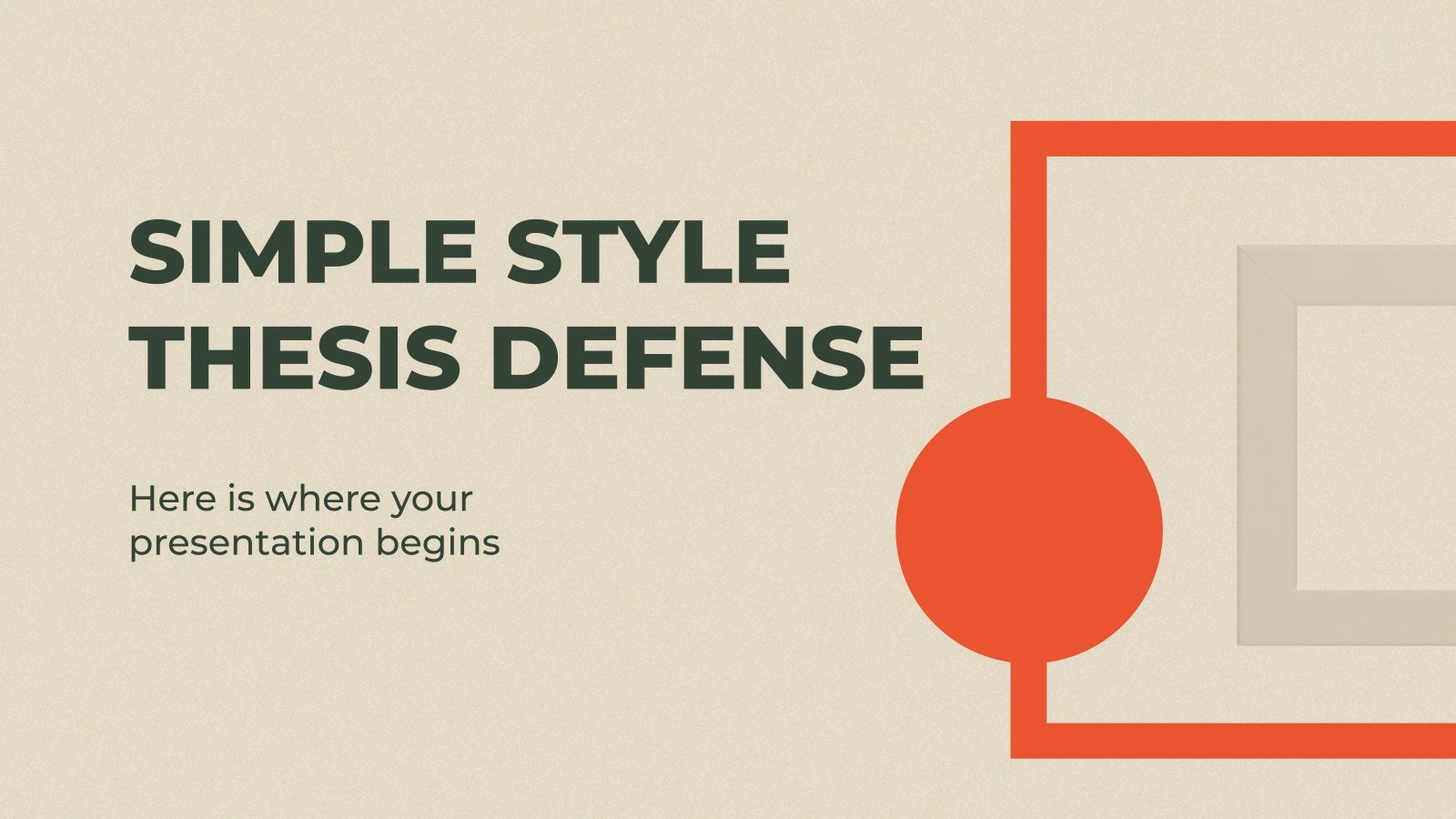
It seems that you like this template!
Simple style thesis defense.
We know how much work involves completing a thesis, and that is why it is also important that you get to impress the committee when making your final presentation. If you are looking for something simple but at the same time formal, take a look at this proposal from Slidesgo....

Premium template
Unlock this template and gain unlimited access
After months or even years of researching about art and a lot of hard work, you’ve at last finished your master’s thesis. Now it’s time for the crucial part: the defense. Impress the committee and get that degree with the help of Slidesgo!

Elegant Bachelor Thesis
Present your Bachelor Thesis in style with this elegant presentation template. It's simple, minimalist design makes it perfect for any kind of academic presentation. With an array of features such as section dividers, images, infographics and more, you can easily create a professional and creative presentation that stands out from...

Monarch Butterfly Thesis Defense Infographics
Download the Monarch Butterfly Thesis Defense Infographics template for PowerPoint or Google Slides and discover the power of infographics. An infographic resource gives you the ability to showcase your content in a more visual way, which will make it easier for your audience to understand your topic. Slidesgo infographics like...

Genocides in History Thesis Defense
Download the Genocides in History Thesis Defense presentation for PowerPoint or Google Slides. Congratulations, you have finally finished your research and made it to the end of your thesis! But now comes the big moment: the thesis defense. You want to make sure you showcase your research in the best...
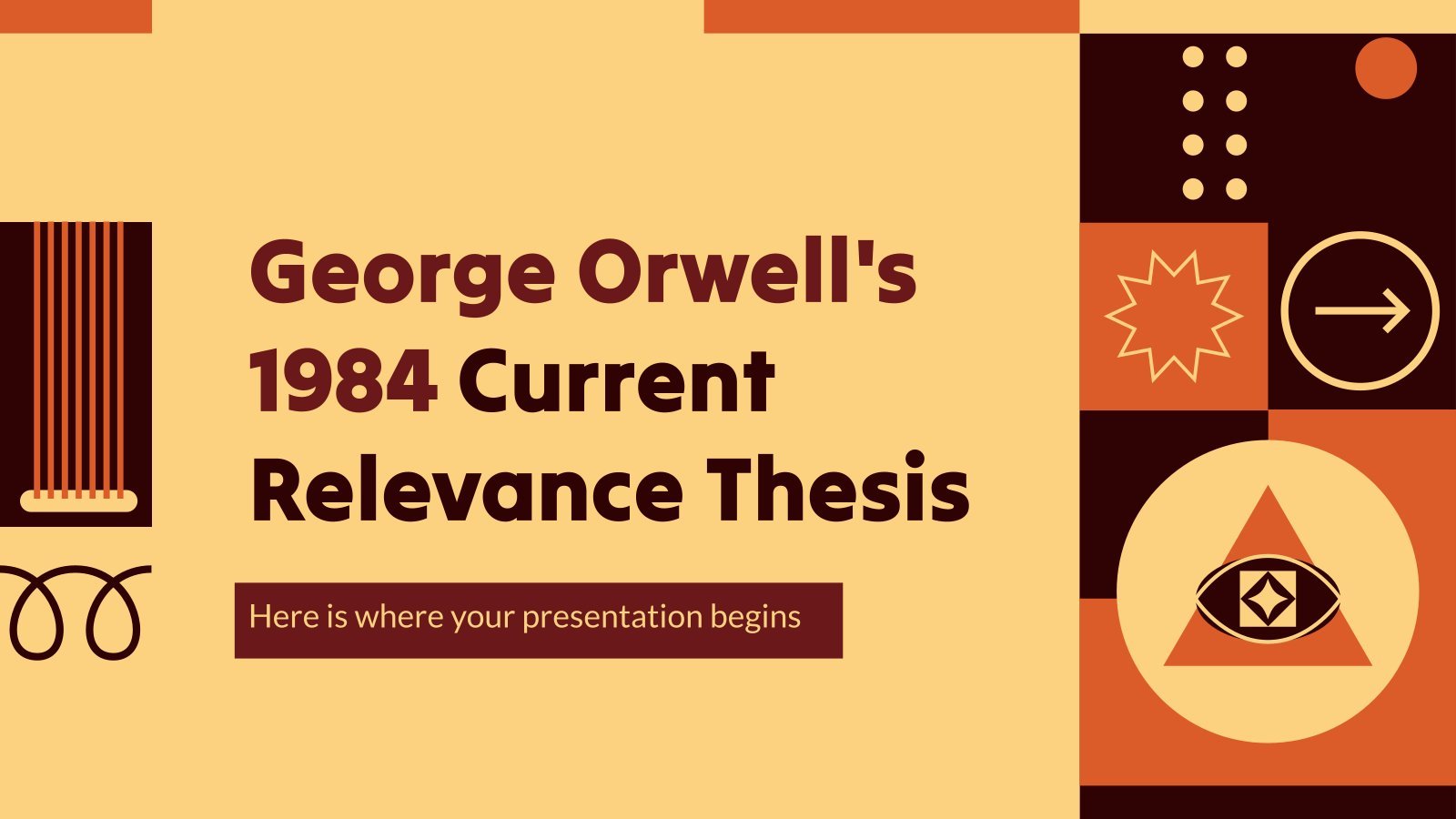
George Orwell's 1984 Current Relevance Thesis
Download the George Orwell's 1984 Current Relevance Thesis presentation for PowerPoint or Google Slides. Congratulations, you have finally finished your research and made it to the end of your thesis! But now comes the big moment: the thesis defense. You want to make sure you showcase your research in the...

US Colonial History: The 13 Colonies Thesis Defense
Download the US Colonial History: The 13 Colonies Thesis Defense presentation for PowerPoint or Google Slides. Congratulations, you have finally finished your research and made it to the end of your thesis! But now comes the big moment: the thesis defense. You want to make sure you showcase your research...

Elegant Black & White Thesis Defense
Present your research findings with grace and assertiveness through this template. Available for Google Slides and PowerPoint, this design set offers minimalistic charm with its simple, gray scale elegance. The template not only provides a polished platform to showcase your thesis but also ensures seamless and efficient delivery of your...
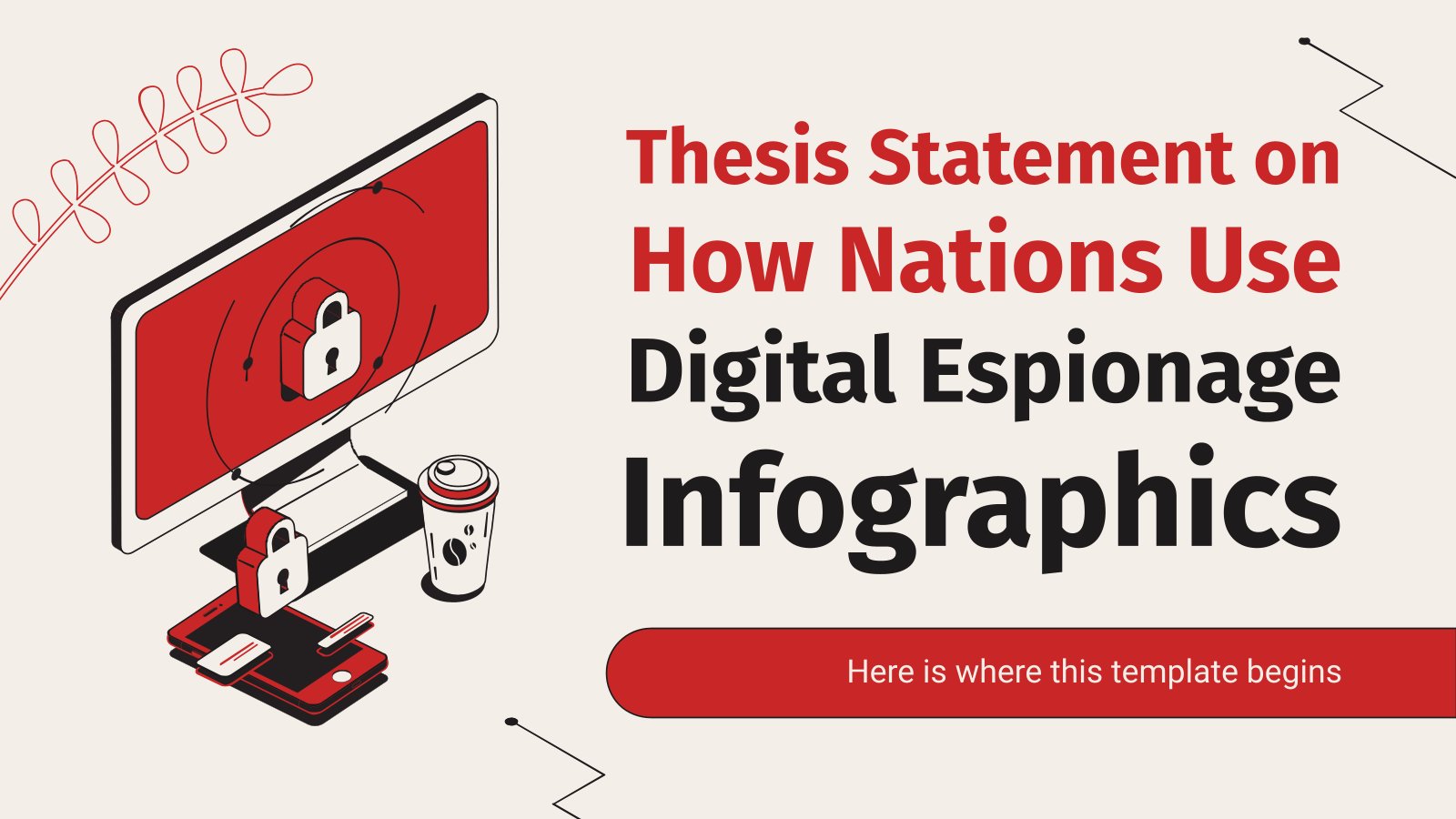
Thesis Statement on How Nations Use Digital Espionage Infographics
Download the Thesis Statement on How Nations Use Digital Espionage Infographics template for PowerPoint or Google Slides and discover the power of infographics. An infographic resource gives you the ability to showcase your content in a more visual way, which will make it easier for your audience to understand your...
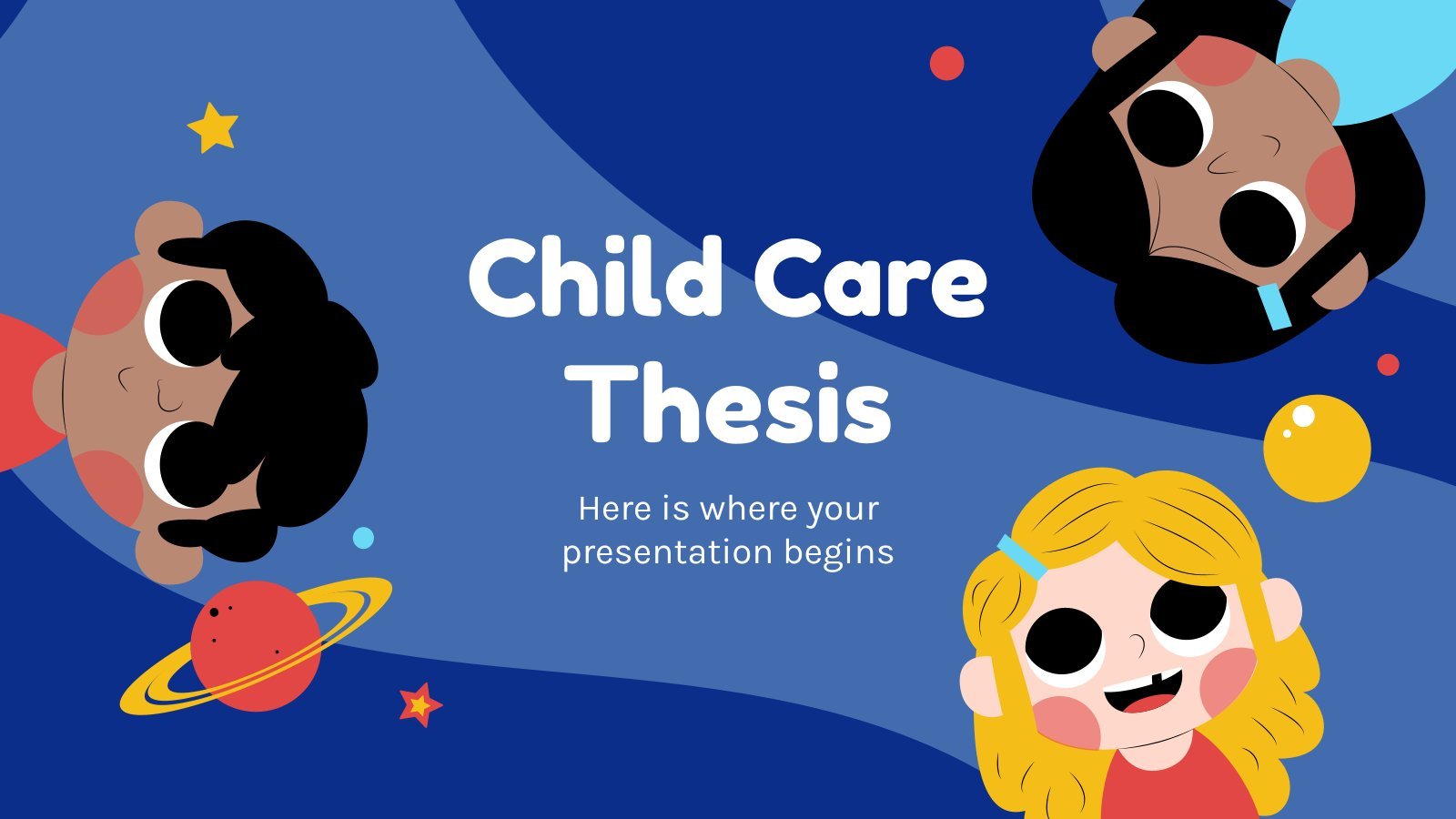
Child Care Thesis
Taking care of kids is not an easy task at times, but it’s quite rewarding! In fact, doing research on how to take care of them will be key for a better future. Present your thesis on child care with this lovely free template!

Egyptian History Thesis
Egyptian history is always a fascinating topic, full of mysteries and secrets. If your thesis is about this and you’re looking for a good way to present your findings clearly, why don’t you give this great template by Slidesgo a try?

The influence of the Generation of '98 Thesis Defense
Download the The influence of the Generation of '98 Thesis Defense presentation for PowerPoint or Google Slides. Congratulations, you have finally finished your research and made it to the end of your thesis! But now comes the big moment: the thesis defense. You want to make sure you showcase your...
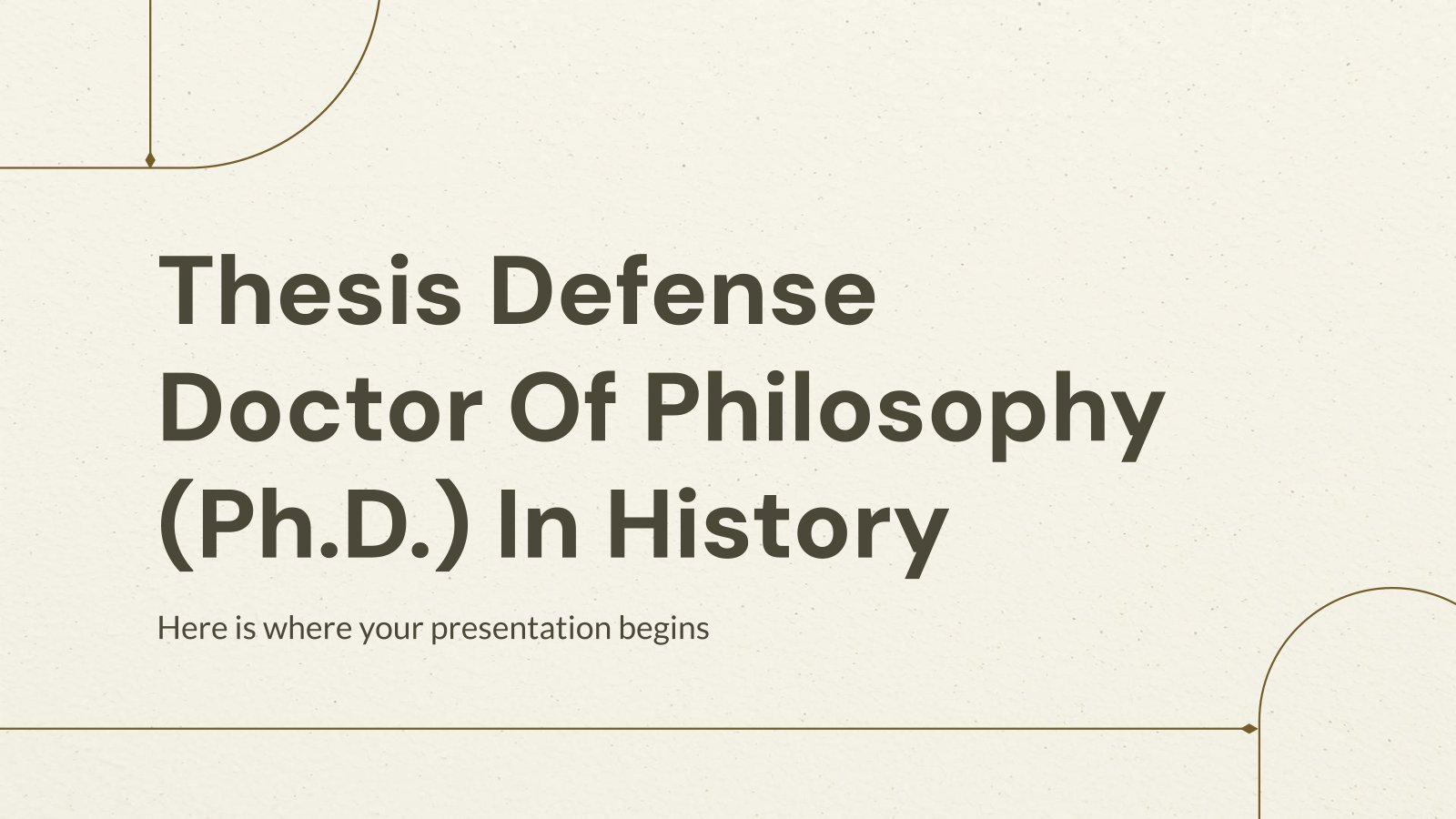
Dissertation Defense - Doctor of Philosophy (Ph.D.) in History
Download the "Dissertation Defense - Doctor of Philosophy (Ph.D.) in History" presentation for PowerPoint or Google Slides. As university curricula increasingly incorporate digital tools and platforms, this template has been designed to integrate with presentation software, online learning management systems, or referencing software, enhancing the overall efficiency and effectiveness of...

Cellular Respiration and its Impact on Health Research Thesis Defense
Download the "Cellular Respiration and its Impact on Health Research Thesis Defense" presentation for PowerPoint or Google Slides. Congratulations, you have finally finished your research and made it to the end of your thesis! But now comes the big moment: the thesis defense. You want to make sure you showcase...

Chemistry Thesis
Everything in this world is composed of atoms and, within science, chemistry is what studies these. Thanks to chemists we can understand what our universe is made of. As a graduate student who has chosen this career path, you’re about to finish your master’s program, but only the thesis defense...

East Asian Studies Thesis
There’s an academic discipline that covers the history, language, culture and other aspects of countries such as China, Japan or Korea. Are you studying a master’s in East Asian Studies and need help with the presentation for the thesis defense? Try our education template!

Neolithic Revolution Thesis Defense
Download the Neolithic Revolution Thesis Defense presentation for PowerPoint or Google Slides. Congratulations, you have finally finished your research and made it to the end of your thesis! But now comes the big moment: the thesis defense. You want to make sure you showcase your research in the best way...
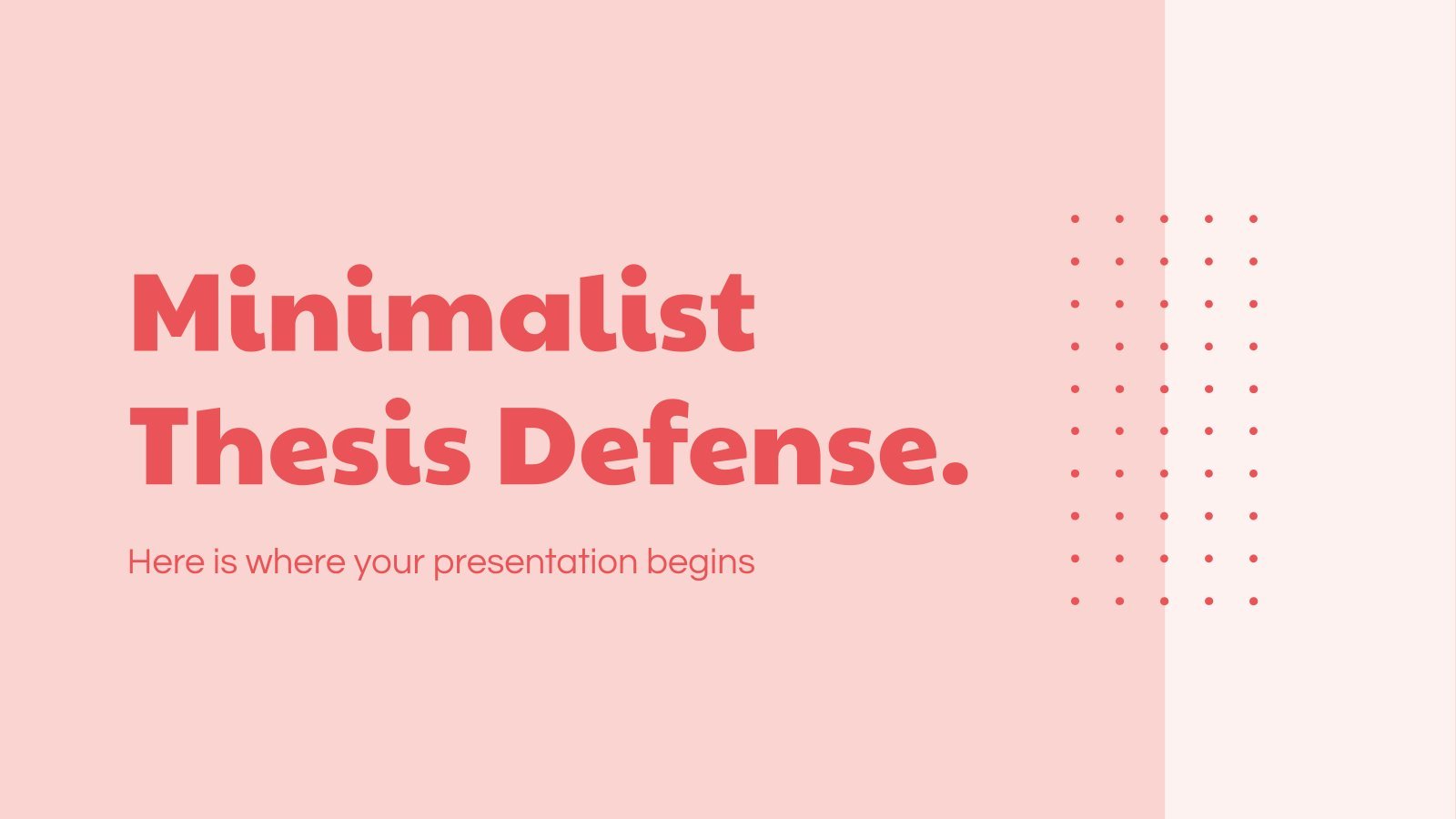
Minimalist Thesis Defense
Get rid of all that nervousness and enter the room full of confidence and willing to impress everyone in your thesis defense. Wait, first you must customize this new template so that your presentation is ready! Nothing feels as boring to the assessment committee than overcrowded slides, so our proposal...
- Page 1 of 47

Register for free and start editing online

Defending Your Dissertation: A Guide

Written by Luke Wink-Moran | Photo by insta_photos
Dissertation defenses are daunting, and no wonder; it’s not a “dissertation discussion,” or a “dissertation dialogue.” The name alone implies that the dissertation you’ve spent the last x number of years working on is subject to attack. And if you don’t feel trepidation for semantic reasons, you might be nervous because you don’t know what to expect. Our imaginations are great at making The Unknown scarier than reality. The good news is that you’ll find in this newsletter article experts who can shed light on what dissertations defenses are really like, and what you can do to prepare for them.
The first thing you should know is that your defense has already begun. It started the minute you began working on your dissertation— maybe even in some of the classes you took beforehand that helped you formulate your ideas. This, according to Dr. Celeste Atkins, is why it’s so important to identify a good mentor early in graduate school.
“To me,” noted Dr. Atkins, who wrote her dissertation on how sociology faculty from traditionally marginalized backgrounds teach about privilege and inequality, “the most important part of the doctoral journey was finding an advisor who understood and supported what I wanted from my education and who was willing to challenge me and push me, while not delaying me. I would encourage future PhDs to really take the time to get to know the faculty before choosing an advisor and to make sure that the members of their committee work well together.”
Your advisor will be the one who helps you refine arguments and strengthen your work so that by the time it reaches your dissertation committee, it’s ready. Next comes the writing process, which many students have said was the hardest part of their PhD. I’ve included this section on the writing process because this is where you’ll create all the material you’ll present during your defense, so it’s important to navigate it successfully. The writing process is intellectually grueling, it eats time and energy, and it’s where many students find themselves paddling frantically to avoid languishing in the “All-But-Dissertation” doldrums. The writing process is also likely to encroach on other parts of your life. For instance, Dr. Cynthia Trejo wrote her dissertation on college preparation for Latin American students while caring for a twelve-year-old, two adult children, and her aging parents—in the middle of a pandemic. When I asked Dr. Trejo how she did this, she replied:
“I don’t take the privilege of education for granted. My son knew I got up at 4:00 a.m. every morning, even on weekends, even on holidays; and it’s a blessing that he’s seen that work ethic and that dedication and the end result.”
Importantly, Dr. Trejo also exercised regularly and joined several online writing groups at UArizona. She mobilized her support network— her partner, parents, and even friends from high school to help care for her son.
The challenges you face during the writing process can vary by discipline. Jessika Iwanski is an MD/PhD student who in 2022 defended her dissertation on genetic mutations in sarcomeric proteins that lead to severe, neonatal dilated cardiomyopathy. She described her writing experience as “an intricate process of balancing many things at once with a deadline (defense day) that seems to be creeping up faster and faster— finishing up experiments, drafting the dissertation, preparing your presentation, filling out all the necessary documents for your defense and also, for MD/PhD students, beginning to reintegrate into the clinical world (reviewing your clinical knowledge and skill sets)!”
But no matter what your unique challenges are, writing a dissertation can take a toll on your mental health. Almost every student I spoke with said they saw a therapist and found their sessions enormously helpful. They also looked to the people in their lives for support. Dr. Betsy Labiner, who wrote her dissertation on Interiority, Truth, and Violence in Early Modern Drama, recommended, “Keep your loved ones close! This is so hard – the dissertation lends itself to isolation, especially in the final stages. Plus, a huge number of your family and friends simply won’t understand what you’re going through. But they love you and want to help and are great for getting you out of your head and into a space where you can enjoy life even when you feel like your dissertation is a flaming heap of trash.”
While you might sometimes feel like your dissertation is a flaming heap of trash, remember: a) no it’s not, you brilliant scholar, and b) the best dissertations aren’t necessarily perfect dissertations. According to Dr. Trejo, “The best dissertation is a done dissertation.” So don’t get hung up on perfecting every detail of your work. Think of your dissertation as a long-form assignment that you need to finish in order to move onto the next stage of your career. Many students continue revising after graduation and submit their work for publication or other professional objectives.
When you do finish writing your dissertation, it’s time to schedule your defense and invite friends and family to the part of the exam that’s open to the public. When that moment comes, how do you prepare to present your work and field questions about it?
“I reread my dissertation in full in one sitting,” said Dr. Labiner. “During all my time writing it, I’d never read more than one complete chapter at a time! It was a huge confidence boost to read my work in full and realize that I had produced a compelling, engaging, original argument.”
There are many other ways to prepare: create presentation slides and practice presenting them to friends or alone; think of questions you might be asked and answer them; think about what you want to wear or where you might want to sit (if you’re presenting on Zoom) that might give you a confidence boost. Iwanksi practiced presenting with her mentor and reviewed current papers to anticipate what questions her committee might ask. If you want to really get in the zone, you can emulate Dr. Labiner and do a full dress rehearsal on Zoom the day before your defense.
But no matter what you do, you’ll still be nervous:
“I had a sense of the logistics, the timing, and so on, but I didn’t really have clear expectations outside of the structure. It was a sort of nebulous three hours in which I expected to be nauseatingly terrified,” recalled Dr. Labiner.
“I expected it to be terrifying, with lots of difficult questions and constructive criticism/comments given,” agreed Iwanski.
“I expected it to be very scary,” said Dr. Trejo.
“I expected it to be like I was on trial, and I’d have to defend myself and prove I deserved a PhD,” said Dr Atkins.
And, eventually, inexorably, it will be time to present.
“It was actually very enjoyable” said Iwanski. “It was more of a celebration of years of work put into this project—not only by me but by my mentor, colleagues, lab members and collaborators! I felt very supported by all my committee members and, rather than it being a rapid fire of questions, it was more of a scientific discussion amongst colleagues who are passionate about heart disease and muscle biology.”
“I was anxious right when I logged on to the Zoom call for it,” said Dr. Labiner, “but I was blown away by the number of family and friends that showed up to support me. I had invited a lot of people who I didn’t at all think would come, but every single person I invited was there! Having about 40 guests – many of them joining from different states and several from different countries! – made me feel so loved and celebrated that my nerves were steadied very quickly. It also helped me go into ‘teaching mode’ about my work, so it felt like getting to lead a seminar on my most favorite literature.”
“In reality, my dissertation defense was similar to presenting at an academic conference,” said Dr. Atkins. “I went over my research in a practiced and organized way, and I fielded questions from the audience.
“It was a celebration and an important benchmark for me,” said Dr. Trejo. “It was a pretty happy day. Like the punctuation at the end of your sentence: this sentence is done; this journey is done. You can start the next sentence.”
If you want to learn more about dissertations in your own discipline, don’t hesitate to reach out to graduates from your program and ask them about their experiences. If you’d like to avail yourself of some of the resources that helped students in this article while they wrote and defended their dissertations, check out these links:
The Graduate Writing Lab
https://thinktank.arizona.edu/writing-center/graduate-writing-lab
The Writing Skills Improvement Program
https://wsip.arizona.edu
Campus Health Counseling and Psych Services
https://caps.arizona.edu
https://www.scribbr.com/

Powerpoint Templates
Icon Bundle
Kpi Dashboard
Professional
Business Plans
Swot Analysis
Gantt Chart
Business Proposal
Marketing Plan
Project Management
Business Case
Business Model
Cyber Security
Business PPT
Digital Marketing
Digital Transformation
Human Resources
Product Management
Artificial Intelligence
Company Profile
Acknowledgement PPT
PPT Presentation
Reports Brochures
One Page Pitch
Interview PPT
All Categories

Example dissertation powerpoint presentation slide
Download and craft this example dissertation PowerPoint presentation slide to make your proposal convincing and appealing. This is one of the best process PPT designs to plan, research and write down the things in a sequence. A professional dissertation PPT template accumulate all the ideas, notes and scribbles to draw up new plans or give a detailed breakdown of the specific chapter. This dissertation Presentation icon offer a layout working on effective planning which is a continuous process and intensify while writing of your dissertation and not something which fades into the background. A user can design a clear question that dissertation hunts to answer. This professionally crafted template plan is helpful to impose order on unmanageable processes. Example dissertation PPT design is one of the indicative structures helping its people with the initial plan. User needs to refer to module guidelines and address the assessment criteria in this editable dissertation PowerPoint Presentation slide. Confound your critics with our Example Dissertation Powerpoint Presentation Slide. Force them to amend their impression.

- Add a user to your subscription for free
You must be logged in to download this presentation.
Do you want to remove this product from your favourites?
PowerPoint presentation slides
Pixel-rich quality of the images and the graphics in the slides. Instant downloading and saving of the slide design. Visually appealing content and the slide graphics. Compatible with Google Slides and offline PowerPoint software. Useful for research scholars and students pursuing higher studies and doctorate degrees.

People who downloaded this PowerPoint presentation also viewed the following :
- Business Slides , Complete Decks , All Decks , Financial Analysis
- Book Design ,
- Comprehensive Examinations ,
- Postgraduate Education ,
- Grey Literature ,
- Dissertations Abstracts
Content of this Powerpoint Presentation
'Simplicity is the ultimate sophistication.'-Leonardo da Vinci.
This timeless message from one of the greatest global artists encapsulates the essence of presentability and art. The same goes for a dissertation. You have toiled for months or even years on your research and have come up with something exciting. Now, you are all set to present it to the analysts. The only thing you need? A powerful dissertation presentation that crafts a narrative to capture the essence of your research.
A well-crafted dissertation presentation serves as the bridge between your work and its audience. It connects viewers at the conscious and subconscious levels to help them understand critical parts of research.
But how exactly do you do that?
A dissertation proposal timeline helps you draw up a solid plan on how to go about the research. Get best-in-class PPT Templates on dissertation proposal timelines here.
Well, our team has prepared this dissertation template to serve that purpose. You can use it to turn your detailed research into a compelling story that your audience will love!
Now, let's take a look at some of the most vital slides of this template.
Every slide in this template is adorned with icons, tables, charts, and bars that are 100% customizable. Thus, you can tailor the template to suit your research.
The planning process is critical to a good dissertation and clearing critical questions and reviews. Access these templates on planning process dissertations here.
Let’s explore the products!
Template #1: Literature Review
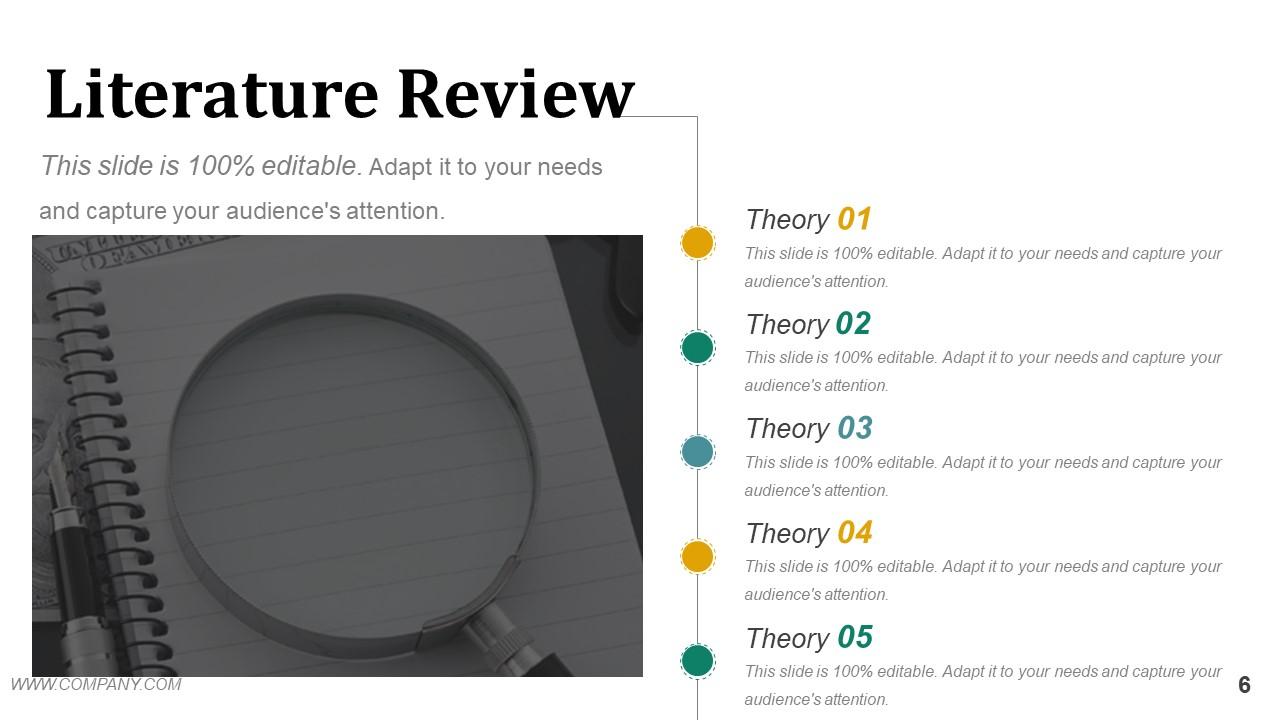
This slide presents a crisp and structured layout that showcases the theories related to your research. The monochromatic backdrop is highlighted by a magnifying glass image showcasing the review's analytical nature. Five color-coded bullet points allow for a clear differentiation between theories. It ensures that each point is identifiable and stands by the audience. The simple and effective color palette with eye-grabbing icons maintains focus on the content and makes it fully functional and visually appealing for viewers.
Template #2: Purpose Statement
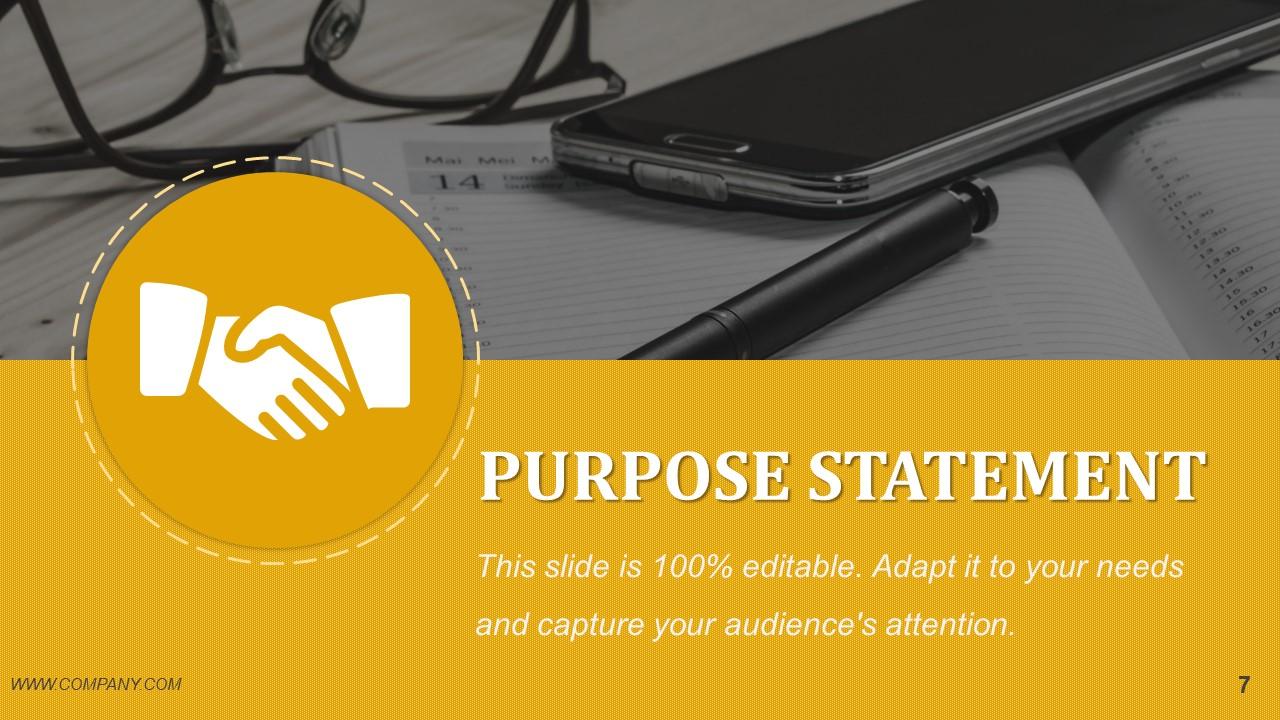
This slide is the cornerstone of your presentation. It succinctly conveys the essence of your entire research. With a confident handshake icon that symbolizes commitment and objectives, it grabs the attention of the audience to the greatest degree. The best part? It's framed against a bold yellow that stands out against a subdued, professional backdrop. This aesthetic color choice grabs the viewer's attention to the crux of your investigation. Here, you articulate the central question your research addresses and set the stage for the value and direction of your scholarly work. This slide is where your study's intent and potential impact are highlighted.
Template #3: Hypothesis
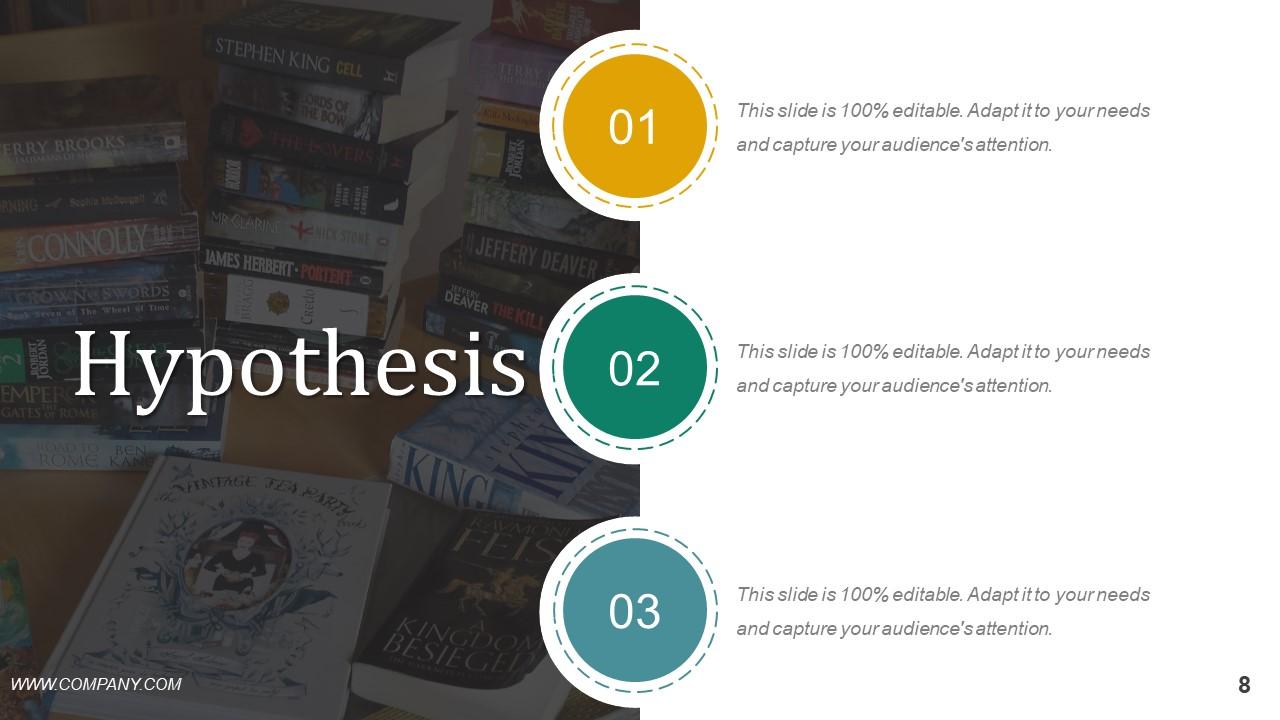
This slide introduces the pivotal propositions of your research. Numbered circular icons guide the viewer through a sequence of hypotheses. Each one of those hypotheses is circled in dashed lines. These lines indicate the iterative nature of scientific enquiry. The backdrop is an array of books that showcase the importance of knowledge and the comprehensive research underpinning your assumptions. The color coding—vivid gold to teal—provides a visual hierarchy. Why? Such color coding helps the audience distinguish and follow each proposed idea.
Template #4: Methods
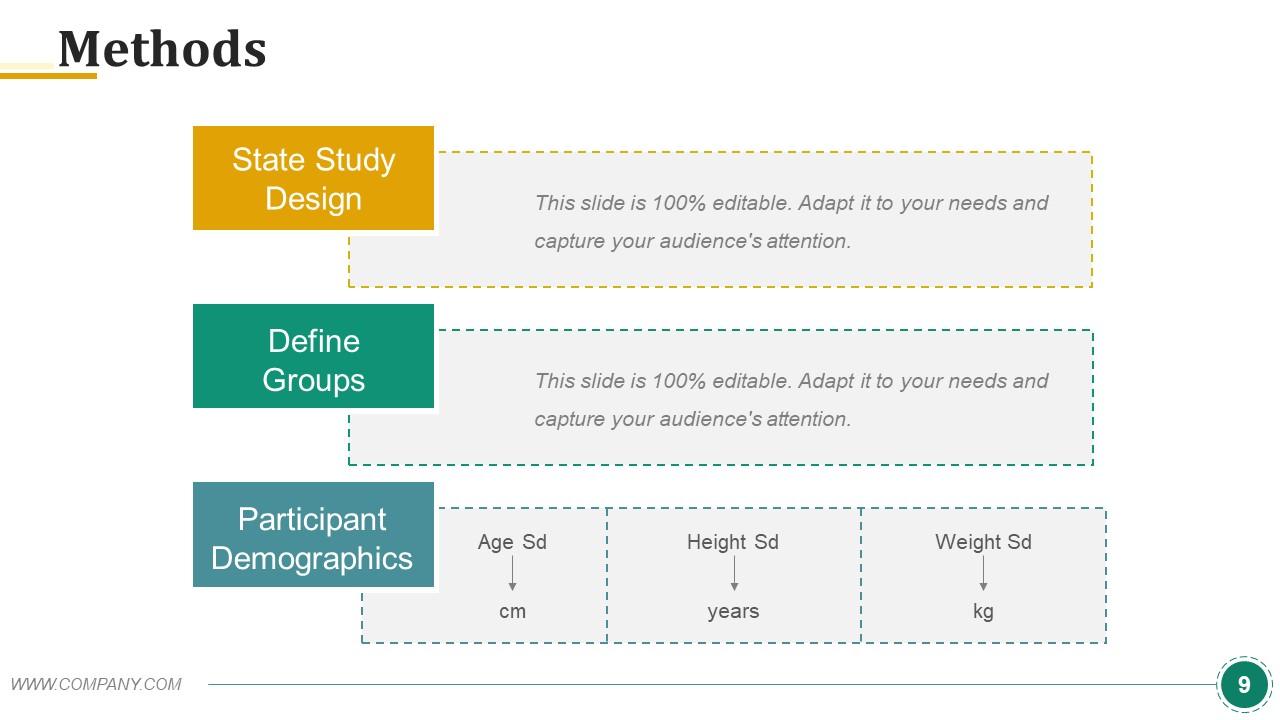
This template marks the blueprint for your in-depth research. It's divided into three primary sections: 'State Study Design,' 'Define Groups,' and 'Participant Demographics.' Each section is segregated with bold color blocks and dashed lines that guide the audience through the systematic approach of your study. The mustard, forest green, and teal color scheme looks visually harmonious but delineates each methodological step. In 'Participant Demographics,' precise age, height, and weight placeholders are also provided. Such attention to detail indicates the depth of your sample's characteristics.
Template #5: Statistical Analysis
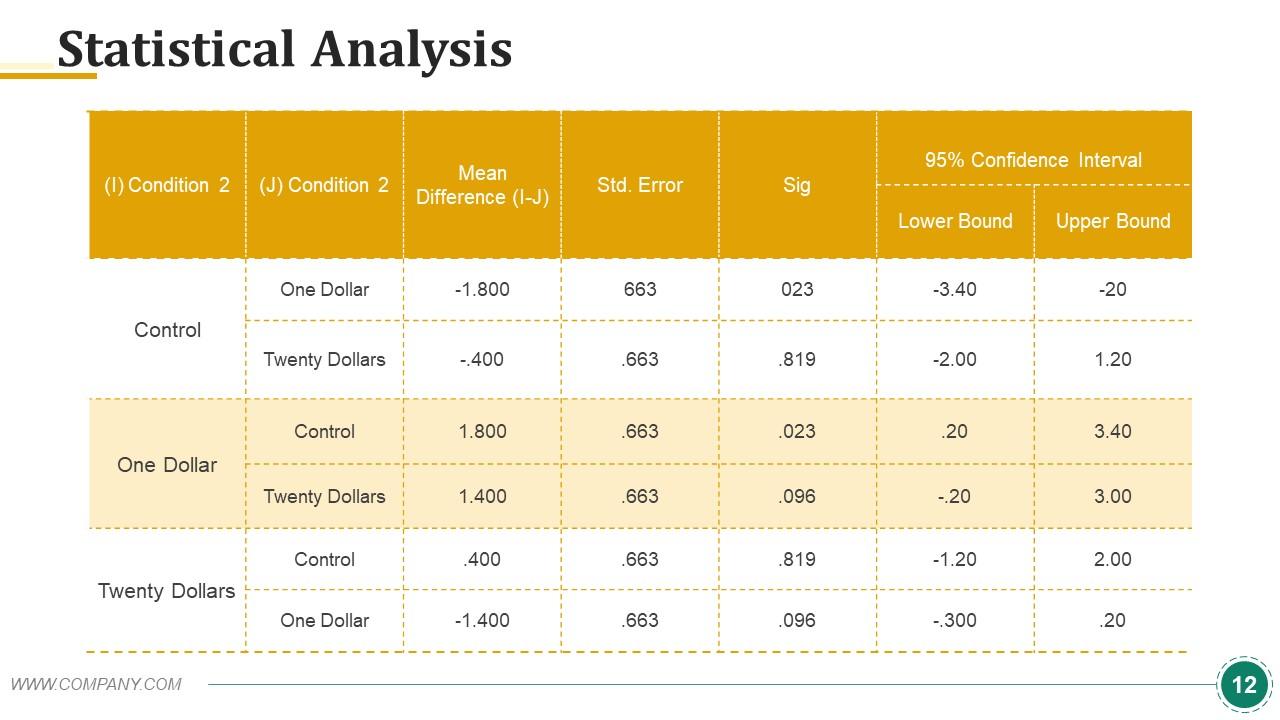
This slide displays the depth of quantitative validation in your research. It presents a table formatted to showcase the statistical comparisons between conditions of your study. The bold header row in a commanding shade of orange draws attention to the key metrics: Mean differences, standard errors, significance levels, and confidence intervals—you name it! The well-structured layout offers a clear, easy-to-follow matrix that expresses the relationships and variances within your data.
Template #6: Results
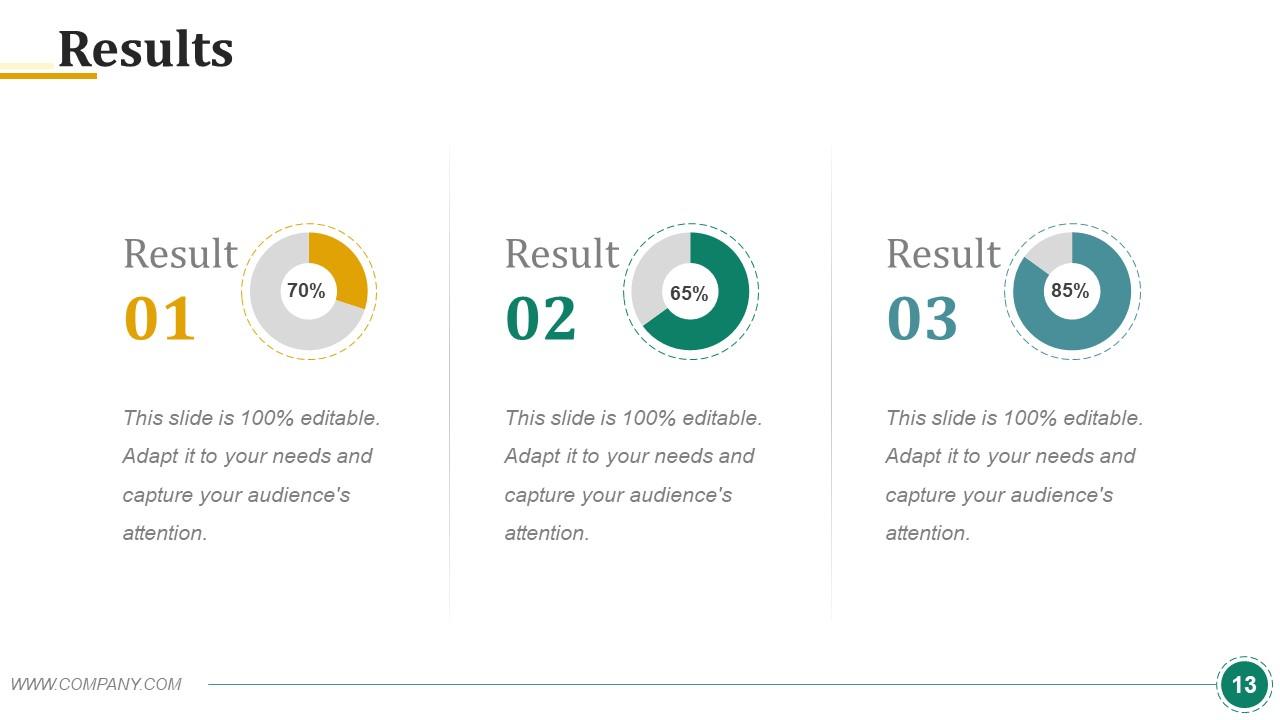
This slide showcases the outcomes of your research in a clear and impactful manner. Each result is showcased with the help of a donut chart! This offers a visual qualification to your findings. The color scheme changes as you go from one result to the next — subdued gold, teal, and blue. Such a color code differentiates each result and maintains the cohesive aesthetic of the presentation. The simplicity of the design ensures that the focus remains on the significance of the results themselves. Result? The audience can grasp the success metrics or key takeaways of your study. This slide highlights the achievements of your research without overwhelming you with details.
Template #7: Discussion
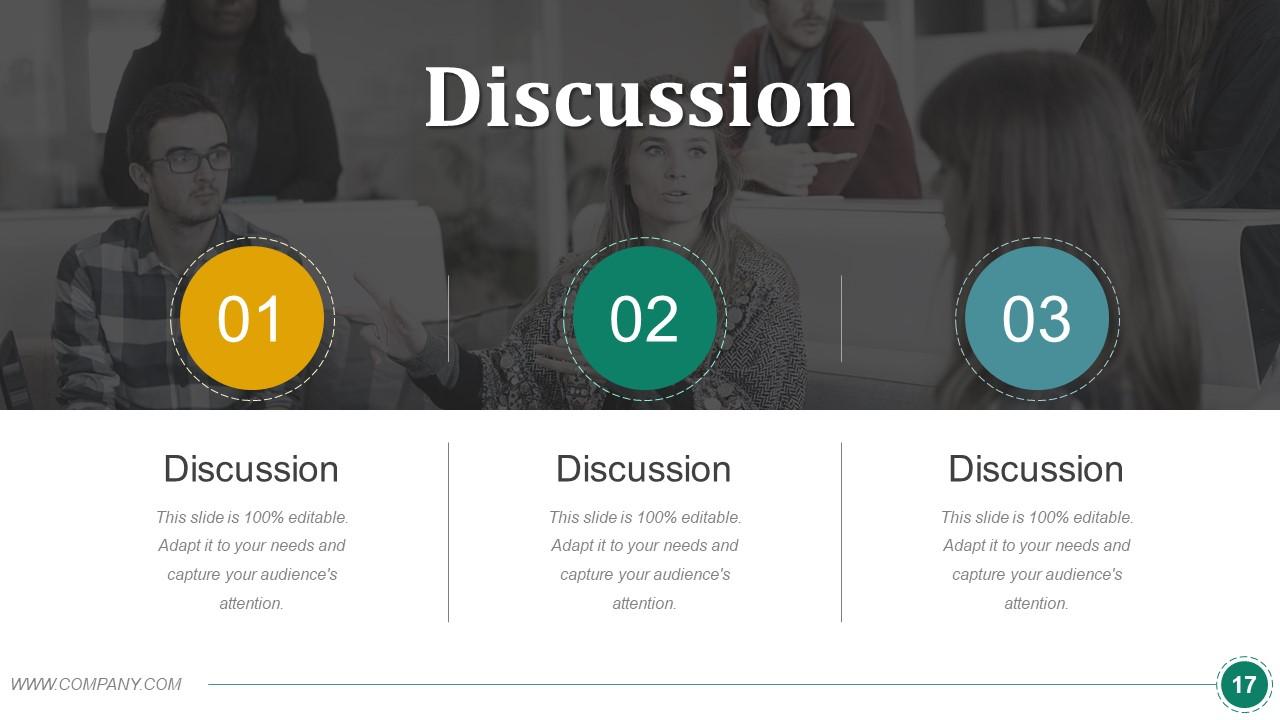
Your research is done, and your results are out, so now what? Well, the next step is to take a deep dive into the implications of your research results. This slide focuses on this. It includes three distinct segments that guide the presentation through key discussion points. This structure provides an organized framework for interpreting the data, exploring the significance of the findings, and considering their impact on the field. The background image sets the stage for an intellectual exchange. It reflects the collaborative and often communal nature of knowledge development. This slide is a platform for critical analysis and promotes thoughtful discussions.
Template #8: Conclusion/Findings
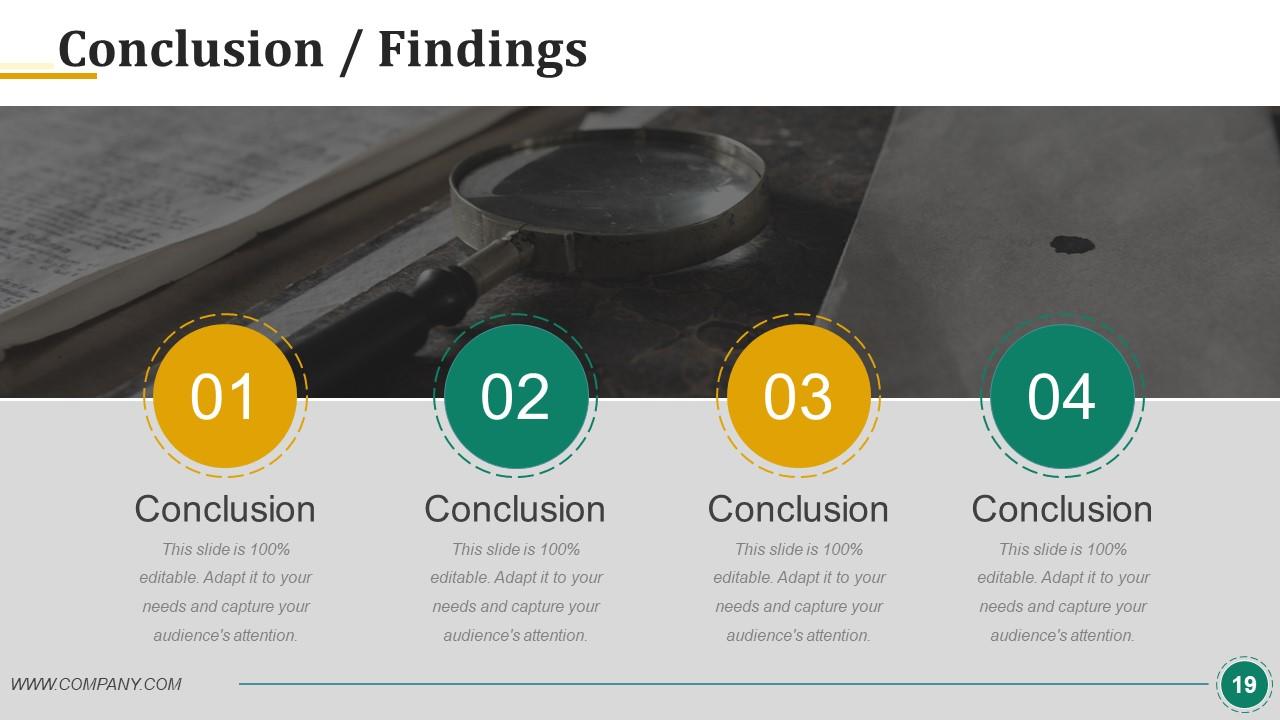
The slide is where the essence of your research is crystallized into key takeaways. It is meant to guide your audience through a sequence of significant revelations. It's segmented into four distinct parts and each one represents a cornerstone of your study's outcomes. The layout facilitates a concise summary of your most impactful results. This leads to a definitive statement of what your work contributes to the field. This slide sums up your presentation, and it is where your research narrative reaches its peak and presents a clear, decisive statement of your findings.
Template #9: Implication for Future Research
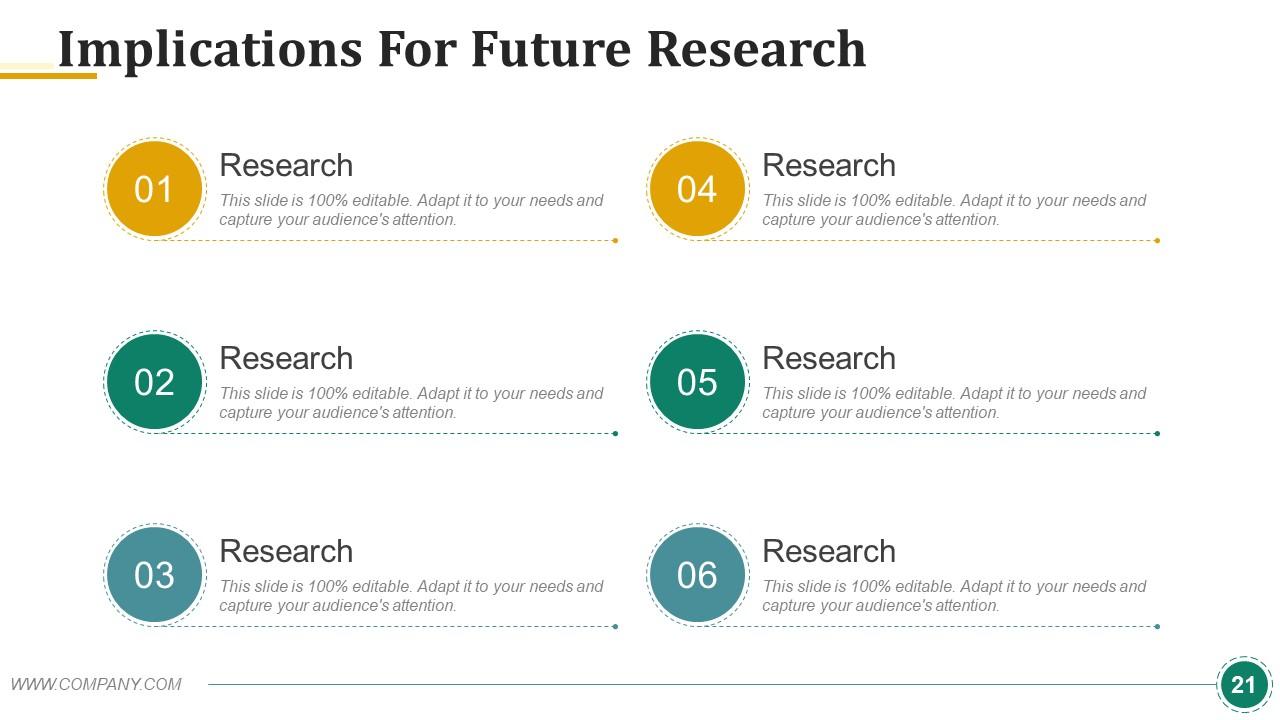
Research is a never-ending field. You reach one conclusion, and multiple potential research can stem from that study. This slide is designed to deal with these research opportunities. It offers six focal areas that highlight where subsequent research can expand upon your work. The slide is organized to prompt consideration of where the academic community can take the insights you've provided. Each segment invites researchers to delve deeper, challenge, or build upon their findings. This ensures the continued evolution of scholarly research in your field.
Template #10: References
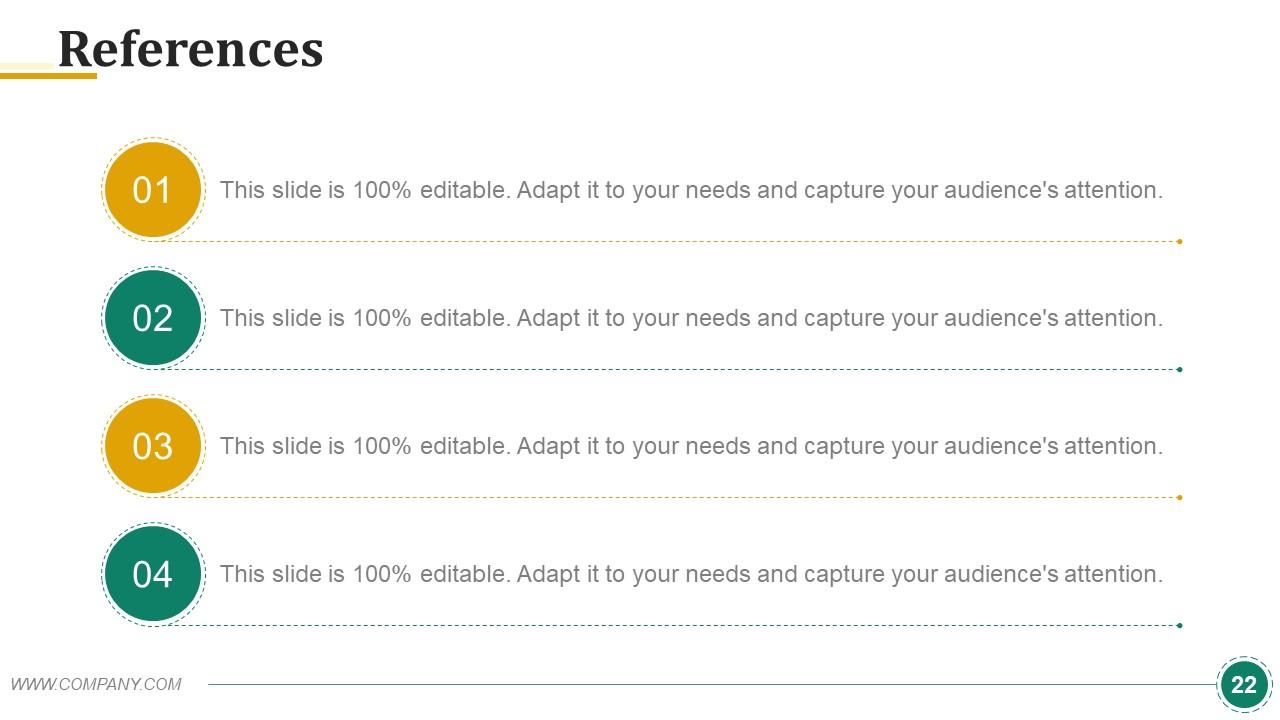
This slide is a scholarly nod to the foundational work you have done for your research. It's a testament to the academic integrity and thoroughness of your study. It lists the sources that support your hypotheses, methodology, and conclusions. This slide acts as the final, crucial link in your research chain. It acknowledges the contributions of others and situates your work within the larger context of existing knowledge.
Charting New Horizons
Dissertation is the essence of your entire research and hard work. It can help you get across the myriads of academic scrutiny. A well-crafted dissertation shares your story through data, theories, and hard-won insights. This template acts as a stepping stone towards that end—articulate, precise, and engaging. Now, it's your turn to take this template and cast your story into the world.
PS A 10-week dissertation report timeline helps you be in time and meet deadlines for research submission. Get these slides here.
Example dissertation powerpoint presentation slide with all 60 slides:
Move towards the center of action with our Example Dissertation Powerpoint Presentation Slide. They help you break away from the fringes.

Ratings and Reviews
by Jones Adams
June 17, 2021
by Duncan Berry
by Ksenia Avdeeva
March 13, 2021

- Accountancy and Control (master)
- Accountancy and Control (premaster)
- Actuarial Science (bachelor)
- Actuarial Science and Mathematical Finance (master)
- American Studies (master)
- Ancient Studies (bachelor)
- Arabische taal en cultuur (bachelor)
- Arbeidsrecht (master)
- Archaeology (master)
- Archaeology (premaster)
- Archaeology (bachelor), EN
- Archaeology and Heritage (research master)
- Archeologie (bachelor), NL
- Archival and Information Studies (duale master)
- Art and Performance Research Studies (research master)
- Artificial Intelligence (master)
- Bèta-gamma (bachelor)
- Bioinformatics and Systems Biology (master, joint degree)
- Biological Sciences (master)
- Biologie (bachelor)
- Biomedical Sciences (master)
- Biomedische wetenschappen (bachelor)
- BMS: Cell Biology and Advanced Microscopy (master)
- BMS: Cognitive Neurobiology and Clinical Neurophysiology (master)
- BMS: Developmental and Therapeutic Biology (master)
- BMS: Experimental Internal Medicine (master)
- BMS: Infection and Immunity (master)
- BMS: Medical Biochemistry and Biotechnology (master)
- BMS: Molecular Neurosciences (master)
- BMS: Oncology (master)
- BMS: Physiology of Synapses and Networks (master)
- BMS: Psychopharmacology and Pathophysiology (master)
- Boekwetenschap (master)
- Boekwetenschap (schakelprogramma)
- Brain and Cognitive Sciences (research master)
- BS: Ecology and Evolution (master)
- BS: Freshwater and Marine Biology (master)
- BS: General Biology (master)
- BS: Green Life Sciences (master)
- Business Administration (bachelor)
- Business Administration (master)
- Business Administration (premaster)
- Business Analytics (bachelor)
- Business Economics (master)
- Business Economics (premaster)
- Chemistry (master, joint degree)
- Chemistry (premaster)
- Chemistry: Analytical Sciences (master, joint degree)
- Chemistry: Molecular Sciences (master, joint degree)
- Chemistry: Science for Energy and Sustainability (master, joint degree)
- Child Development and Education (research master)
- Classics and Ancient Civilizations (master)
- Cognition, Language and Communication (bachelor)
- Commerciële rechtspraktijk (master)
- Communicatiewetenschap (bachelor)
- Communication and Information (duale master)
- Communication Science (bachelor)
- Communication Science (master)
- Communication Science (premaster)
- Communication Science (research master)
- Comparative Cultural Analysis (master)
- Comparative Literature (master)
- Computational Science (master, joint degree)
- Computational Social Science (bachelor)
- Computer Science (master, joint degree)
- Conflict Resolution and Governance (master)
- Conservation and Restoration of Cultural Heritage (master)
- Cultural Analysis (research master)
- Cultural and Social Anthropology (master)
- Cultural and Social Anthropology (premaster)
- Cultural Anthropology and Development Sociology (bachelor)
- Culturele antropologie en ontwikkelingssociologie (bachelor)
- Cultuurwetenschappen (bachelor)
- Curating Art and Cultures (duale master)
- Data Science (master)
- Data Science and Business Analytics (master)
- Documentaire en fictie (duale master)
- Duits, Educatie en communicatie (master)
- Duits, Educatie en communicatie (schakelprogramma)
- Duitslandstudies (bachelor)
- Duitslandstudies (master)
- Earth Sciences (master)
- East European Studies (master)
- Econometrics (master)
- Econometrics (premaster)
- Econometrics and Data Science (bachelor)
- Economics (master)
- Economics (premaster)
- Economics and Business Economics (bachelor)
- Engels, Educatie en communicatie (master)
- Engels, Educatie en communicatie (schakelprogramma)
- English Language and Culture (bachelor)
- English Literature and Culture (master)
- Entrepreneurship (master)
- ES: Environmental Management (master)
- ES: Future Planet Ecosystem Science (master)
- ES: Geo-Ecological Dynamics (master)
- European Competition Law and Regulation (master)
- European Policy (master)
- European Private Law (master)
- European Studies (bachelor)
- European Studies (premaster)
- European Union Law (master)
- Europese studies (bachelor)
- Exchange programme Economics and Business
- Exchange programme Humanities
- Exchange programme Law - Amsterdam Law School
- Exchange programme PPLE - Politics, Psychology, Law and Economics
- Exchange programme Science
- Exchange programme Social and Behavioural Sciences
- Film Studies (master)
- Filosofie (bachelor)
- Filosofie (master)
- Finance (master)
- Fiscaal Recht (bachelor)
- Fiscaal Recht (master)
- Fiscale Economie (bachelor)
- Fiscale Economie (master)
- Fiscale Economie (premaster)
- Forensic Science (master)
- Frans, Educatie en communicatie (master)
- Frans, Educatie en communicatie (schakelprogramma)
- Franse taal en cultuur (bachelor)
- Future Planet Studies (bachelor)
- Geneeskunde (bachelor)
- Geneeskunde (master)
- Geneeskunde (schakelprogramma)
- General Linguistics (master)
- Geschiedenis (bachelor)
- Geschiedenis (master)
- Geschiedenis (research master)
- Geschiedenis (schakelprogramma)
- Geschiedenis van de internationale betrekkingen (master)
- Geschiedenis, Educatie en communicatie (master)
- Gezondheidsrecht (master)
- Gezondheidszorgpsychologie (master)
- Global Arts, Culture and Politics (bachelor)
- Griekse en Latijnse taal en cultuur (bachelor)
- Hebreeuwse taal en cultuur (bachelor)
- Heritage and Memory Studies (duale master)
- Holocaust and Genocide Studies (master)
- Human Geography (master)
- Human Geography (premaster)
- Human Geography and Planning (bachelor)
- Identity and Integration (master)
- Informatica (bachelor)
- Informatiekunde (bachelor)
- Informatierecht (master)
- Information Studies (master)
- Information Systems (master)
- Interdisciplinaire sociale wetenschap (bachelor)
- Internationaal en Europees belastingrecht (master)
- International and Transnational Criminal Law (master)
- International Criminal Law - Joint programme with Columbia Law School (master)
- International Development Studies (master)
- International Development Studies (premaster)
- International Development Studies (research master)
- International Dramaturgy (duale master)
- International Dramaturgy and Theatre Studies (premaster)
- International Tax Law (advanced master)
- International Trade and Investment Law (master)
- Italië Studies (bachelor)
- Jewish Studies (master)
- Journalism, Media and Globalisation (Erasmus Mundus Master's - joint degree)
- Journalistiek en media (duale master)
- Kunst, cultuur en politiek (master)
- Kunst, cultuur en politiek (schakelprogramma)
- Kunstgeschiedenis (bachelor)
- Kunstgeschiedenis (master)
- Kunstgeschiedenis (schakelprogramma)
- Kunstmatige intelligentie (bachelor)
- Language and Society (master)
- Language, Literature and Education (master)
- Language, Literature and Education (premaster)
- Latin American Studies (master)
- Latin American Studies (premaster)
- Law & Finance (master)
- Lerarenopleidingen
- Linguistics (bachelor)
- Linguistics (premaster)
- Linguistics and Communication (research master)
- Literary and Cultural Analysis (bachelor)
- Literary Studies (premaster)
- Literary Studies (research master)
- Literature, Culture and Society (master)
- Logic (master)
- Mathematics (master)
- Media and Culture (bachelor)
- Media and Information (bachelor)
- Media en cultuur (bachelor)
- Media Studies (premaster)
- Media Studies (research master)
- Medical Anthropology and Sociology (master)
- Medical Anthropology and Sociology (premaster)
- Medical informatics (master)
- Medische informatiekunde (bachelor)
- Midden-Oostenstudies (master)
- Midden-Oostenstudies (schakelprogramma)
- Militaire geschiedenis (master)
- Museum Studies (duale master)
- Music Studies (master)
- Music Studies (premaster)
- Muziekwetenschap (bachelor)
- Natuurkunde en sterrenkunde (bachelor, joint degree)
- Nederlands als tweede taal en meertaligheid (duale master)
- Nederlands als tweede taal en meertaligheid (schakelprogramma)
- Nederlands, Educatie en communicatie (master)
- Nederlands, Educatie en communicatie (schakelprogramma)
- Nederlandse taal en cultuur (bachelor)
- Nederlandse taal en cultuur (master)
- New Media and Digital Culture (master)
- Nieuwgriekse taal en cultuur (bachelor)
- Onderwijswetenschappen (bachelor)
- Onderwijswetenschappen (master)
- Onderwijswetenschappen (schakelprogramma)
- (Forensische) Orthopedagogiek (schakelprogramma)
- Oudheidwetenschappen (bachelor)
- P&A: Advanced Matter and Energy Physics (master, joint degree)
- P&A: Astronomy and Astrophysics (master, joint degree)
- P&A: Biophysics and Biophotonics (master, joint degree)
- P&A: General Physics and Astronomy (master, joint degree)
- P&A: GRAPPA - Gravitation, Astro-, and Particle Physics (master, joint degree)
- P&A: Science for Energy and Sustainability (master, joint degree)
- P&A: Theoretical Physics (master, joint degree)
- Pedagogical Sciences (master)
- Pedagogische wetenschappen (bachelor)
- Pedagogische wetenschappen (master)
- Philosophy (master)
- Philosophy (research master)
- Philosophy of the Humanities and the Social Sciences (master)
- Philosophy of the Humanities and the Social Sciences (schakelprogramma)
- Physics and Astronomy (master, joint degree)
- Political Science (bachelor)
- Political Science (master)
- Political Science (premaster)
- Politicologie (bachelor)
- PPLE - Politics, Psychology, Law and Economics (bachelor)
- Preservation and Presentation of the Moving Image (duale master)
- Preventieve jeugdhulp en opvoeding (schakelprogramma)
- Privaatrechtelijke rechtspraktijk (master)
- Psychobiologie (bachelor)
- Psychologie (schakelprogramma)
- Psychologie (bachelor), NL
- Psychologie (master), NL
- Psychology (premaster)
- Psychology (bachelor), EN
- Psychology (master), EN
- Psychology (research master), EN
- Public International Law (master)
- Publieksgeschiedenis (master)
- Rechtsgeleerdheid (bachelor)
- Rechtsgeleerdheid met HBO-vooropleiding (schakelprogramma)
- Rechtsgeleerdheid met WO-vooropleiding (schakelprogramma)
- Redacteur/editor (duale master)
- Religiewetenschappen (bachelor)
- Religious Studies (research master)
- Russische en Slavische studies (bachelor)
- Scandinavië studies (bachelor)
- Scheikunde (bachelor, joint degree)
- Security and Network Engineering (master)
- Sign Language Linguistics (bachelor)
- Social Sciences (research master)
- Sociale geografie en Planologie (bachelor)
- Sociologie (bachelor)
- Sociology (bachelor)
- Sociology (master)
- Sociology (premaster)
- Software Engineering (master)
- Spaanse en Latijns-Amerikaanse studies (bachelor)
- Spirituality and Religion (master)
- Spirituality and Religion (schakelprogramma)
- Staats- en bestuursrecht (master)
- Stads- en architectuurgeschiedenis (master)
- Stochastics and Financial Mathematics (master)
- Strafrecht (master)
- Taalwetenschappen (bachelor)
- Television and Cross-Media Culture (master)
- Theaterwetenschap (bachelor)
- Theatre Studies (master)
- Universitaire Pabo van Amsterdam (bachelor)
- Urban and Regional Planning (master)
- Urban and Regional Planning (premaster)
- Urban Studies (research master)
- Vertalen (master)
- Vertalen (schakelprogramma)
- Wiskunde (bachelor)
For current information about the demonstrations, see uva.nl/protests External link .

Presentation Master's Thesis - Jannes van Beek - Developmental psychology
Roeterseilandcampus - Gebouw G, Straat: Nieuwe Achtergracht 129-B, Ruimte: GS.05
The use of social media has become widespread, with 45% of adolescents reporting near-constant online activity. 7.4% of European adolescents exhibit signs of problematic social media use (PSMU), characterized by an inability to stop using social media and neglect of one’s health and functioning in several life domains. Previous research indicates that individuals with ADHD are more prone to develop PSMU. This thesis investigates the role of inhibition deficits, commonly linked to both ADHD and PSMU, and hypothesizes that these deficits mediate the relationship between ADHD and PSMU. The research question is as follows: “To what extent does the mediating effect of inhibition explain the relationship between ADHD and problematic social media use?” To explore this, we conducted a cross-sectional, correlational, pilot study with 111 participants. During the presentation I will discuss the findings, implications, and potential for future research.

IMAGES
VIDEO
COMMENTS
12 Free presentation templates for a Thesis Defense; Define your signature idea. Your thesis has a focus. A goal. A core concept. And this should be incorporated into your thesis defense presentation's design in every respect. A strong design will help to engage the committee and reinforce your expert understanding of your research area.
The best way to prepare for your Dissertation Presentation is to review your work carefully. Take notes of the key decisions you have made throughout your research and the scholarly literature that supports these choices. Make sure that you have a thorough understanding of the scholarly context of your research, which should have been achieved ...
Use an appropriate language register (avoid informal language), but be approachable and natural. "Welcome to the thesis defense on [the title of your thesis]". Next, introduce yourself with your name and give a short description of your background and occupation. Don't forget to say "thank you for attending!".
Tip #3: Choose an eye-catching visual… or make one 👀. In the same way that 'the hook' in your 3MT script helps to pique the audience's attention, the slide is another important tool to capture their attention and keep them engaged. But to do this, it needs to be eye-catching and interesting.
Presentations with strong narrative arcs are clear, captivating, and compelling. Orient the audience and draw them in by demonstrating the relevance and importance of your research story with strong global motive. Provide them with the necessary vocabulary and background knowledge to understand the plot of your story.
A dissertation is usually written over an extended period and is expected to contribute new knowledge or insights to the field. Unlike a thesis presentation, a dissertation is submitted in written form and is typically evaluated by a committee of faculty members or experts in the field. 2. Choose which ideas to illustrate
Purpose of the Guide. This Guide was created to help Ph.D. students in engineering fields to design dissertation defense presentations. The Guide provides 1) tips on how to effectively communicate research, and 2) full presentation examples from Ph.D. graduates. The tips on designing effective slides are not restricted to dissertation defense ...
2. Know Your Audience. Most people give their thesis defense presentation to an academic panel. This panel will look to see if you've developed a thorough understanding of your topic and thesis. They'll also be looking to see if you've got a solid foundation for your argument.
1. Get inspired. It's a good idea to start by reflecting to inspire yourself and to figure out what content to include in your presentation. Take time to get information from different sources. For example: Speak to students who have given a presentation in the same subject in previous years or semesters.
A strong thesis defense is crucial for any doctorate or graduate student. Although researching and writing about your thesis topic can be a Herculean effort, the work doesn't end there. The thesis presentation is a crucial part of the dissertation defense in many academic programs. Your impressive presentation will show the depth of research in your thesis clearly and compellingly. Your ...
Myth #1. "Answer all the questions correctly. Otherwise, your thesis won't get approved.". You are expected to have a focus on your research. That being said, you have to study each part of your thesis, every detail, and even your sources. You have to study and practice how to effectively deliver your presentation.
A coherent structure is essential for guiding your audience through your thesis defense presentation. Prezi can help by offering a map view of your content's layout upfront, providing a clear path through your introduction, methodology, results, and conclusion. This clarity keeps your audience engaged and makes your arguments easier to follow.
Link to examples dissertation defense slides. Email me for questions and schedule an appointment. Chasz Griego ... During your presentation, the committee members can use page numbers to reference specific slides for their questions. ... Use animations to explain complicated ideas in figures, tables, etc. You can use different slides instead of ...
The PhD Dissertation PowerPoint Template provides a professional structure and layouts designed for dissertation presentations. A dissertation is the work submitted to support the conclusion of an academic degree or professional qualification, presenting the author's research and findings in an area of study.
Free Google Slides theme and PowerPoint template. In order to achieve the highest academic degree there is, you need the best presentation for your dissertation. Years of hard work will pay off with this free template by Slidesgo, which can help you focus on your message without having to worry about the visual design. The color palette is ...
Prize-Winning Thesis and Dissertation Examples. Published on September 9, 2022 by Tegan George.Revised on July 18, 2023. It can be difficult to know where to start when writing your thesis or dissertation.One way to come up with some ideas or maybe even combat writer's block is to check out previous work done by other students on a similar thesis or dissertation topic to yours.
In simple terms, it is a presentation made by a student to defend all the ideas and views that are presented in a dissertation. The presenter must include details like what is the reason for choosing specific research methods, the theory that has been selected for the paper, and other such points.
Dissertation & Thesis Outline | Example & Free Templates. Published on June 7, 2022 by Tegan George.Revised on November 21, 2023. A thesis or dissertation outline is one of the most critical early steps in your writing process.It helps you to lay out and organize your ideas and can provide you with a roadmap for deciding the specifics of your dissertation topic and showcasing its relevance to ...
Templates for everything under the sun ☀️. Sign up to explore 2000+ interactive, animated designs in the Genially Template Gallery. Impress your professors with a stunning thesis defense presentation. Choose from 100s of free slide templates for Final Year Projects, Bachelor, Master & Postgrad students.
Suggested Order For Writing: The easiest way to build a dissertation is inside-out. Begin by writing the chapters that describe your research (3, 4, and 5 in the above outline). Collect terms as they arise and keep a definition for each. Define each technical term, even if you use it in a conventional manner.
Download the "Dissertation Defense - Doctor of Philosophy (Ph.D.) in History" presentation for PowerPoint or Google Slides. As university curricula increasingly incorporate digital tools and platforms, this template has been designed to integrate with presentation software, online learning management systems, or referencing software, enhancing ...
The first thing you should know is that your defense has already begun. It started the minute you began working on your dissertation— maybe even in some of the classes you took beforehand that helped you formulate your ideas. This, according to Dr. Celeste Atkins, is why it's so important to identify a good mentor early in graduate school.
A professional dissertation PPT template accumulate all the ideas, notes and scribbles to draw up new plans or give a detailed breakdown of the specific chapter. ... This dissertation Presentation icon offer a layout working on effective planning which is a continuous process and intensify while writing of your dissertation and not something ...
Use clear and legible fonts, and maintain a consistent design throughout the presentation. 2. Visual appeal: Incorporate visually appealing elements such as relevant images, charts, graphs, or diagrams. Use high-quality visuals that enhance understanding and make the content more engaging.
Presentation Master's Thesis - Jannes van Beek - Developmental psychology. Last modified on 30-05-2024 13:41. share. ... This thesis investigates the role of inhibition deficits, commonly linked to both ADHD and PSMU, and hypothesizes that these deficits mediate the relationship between ADHD and PSMU. ... Important topics Toggle item. Go to ...